Firetruck diplomacy 🇵🇦 🇨🇷 🇳🇮
Since last writing I’ve left South America and I’m currently cycling through Central America. I crossed the Darian gap by sailboat and arrived in Panama on the Caribbean coast. After spending a few days in Panama City I continued along the Pacific coast through Costa Rica and into Nicaragua. Currently I’m taking a few rest days in León before hitting the road again for higher and cooler climes near the Honduran border.
Sailing through the San Blas archipelago to Panama
Long before arriving in Cartagena, Colombia I had thought about how to cross the Darien Gap, a thick, roadless, and fairly lawless section of jungle comprising the border between Colombia and Panama. Out of desparation, many thousands of people hike across it every year on their way to the United States. They pay off the cartels that effectively control the jungle who then allow them to hike through over the course of several days. Of course, there are stories, tall tales of several tourists who have gone this way but I found that idea both stupid risky and disrespectful. Alternatively, one can take a series of small lanchas (i.e. boats) westward starting in Turbo, Colombia. This has also been well documented by a few cyclists. It’s also not cheap and not certain. Lastly, one can of course always fly from Bogota to Panama City.
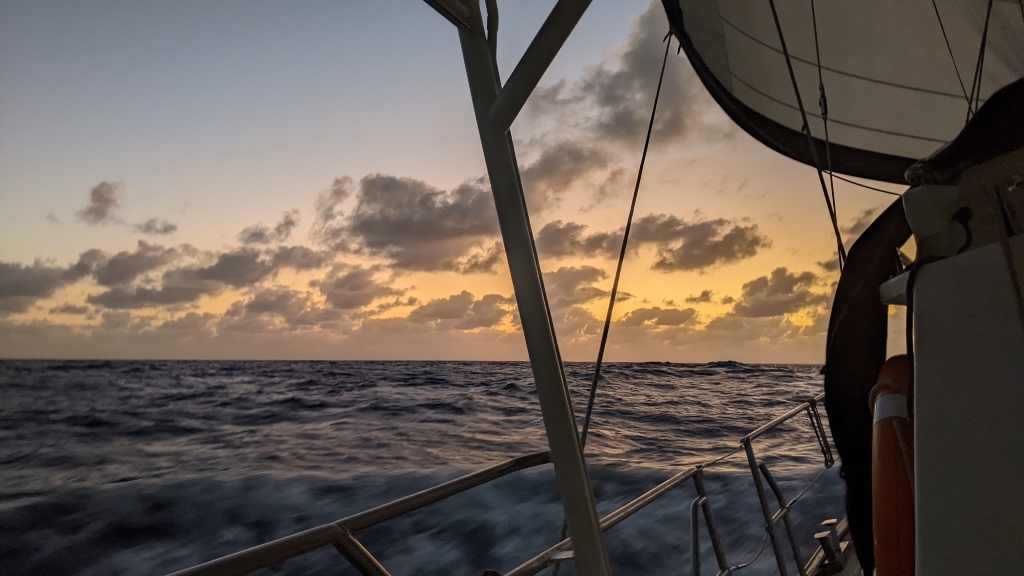
Underway on the first evening

Guna fishermen selling lobster
I decided to splurge for the most fancy option by taking a five day sailboat ride from Cartagena to Puerto Lindo, Panama. I was conflicted about leaving South America in this fashion because in the many months that I’ve been on the road I’ve been helped, housed, and fed by many, many people for whom such a trip would never even fall within the realm of possibility. A few days before arriving in Cartagena I got caught in a rainstorm sometime around 5 PM. I sought shelter under a small tin roof and asked some kids playing outside if I could wait there. A man eventually came out and we chatted; it was his house. After a brief chat I was given a plate of food, some salchipapas, and offered to spend the night inside. Sometimes when this happened I just couldn’t bring myself to explain that I’d left a perfectly comfortable engineering job to take a lot of time off to go “find myself.” So I lied and made something up. Granted, there’s always the possibility that I’m overanalyzing the whole thing and they’d think “sure whatever, dude”
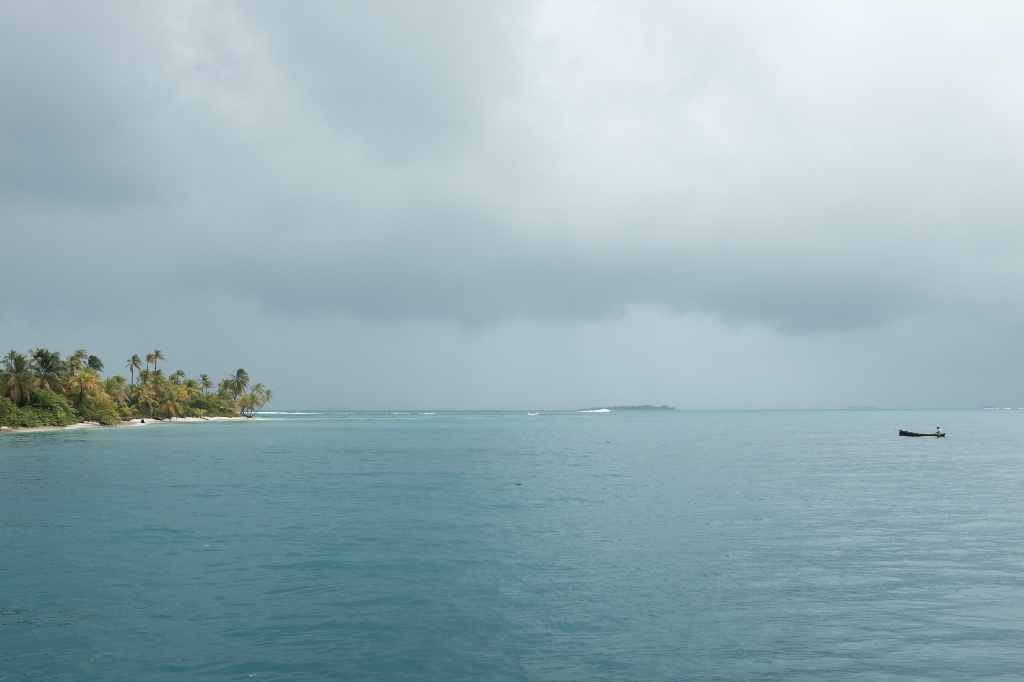
Some rainy days to start

My bike was along for the ride
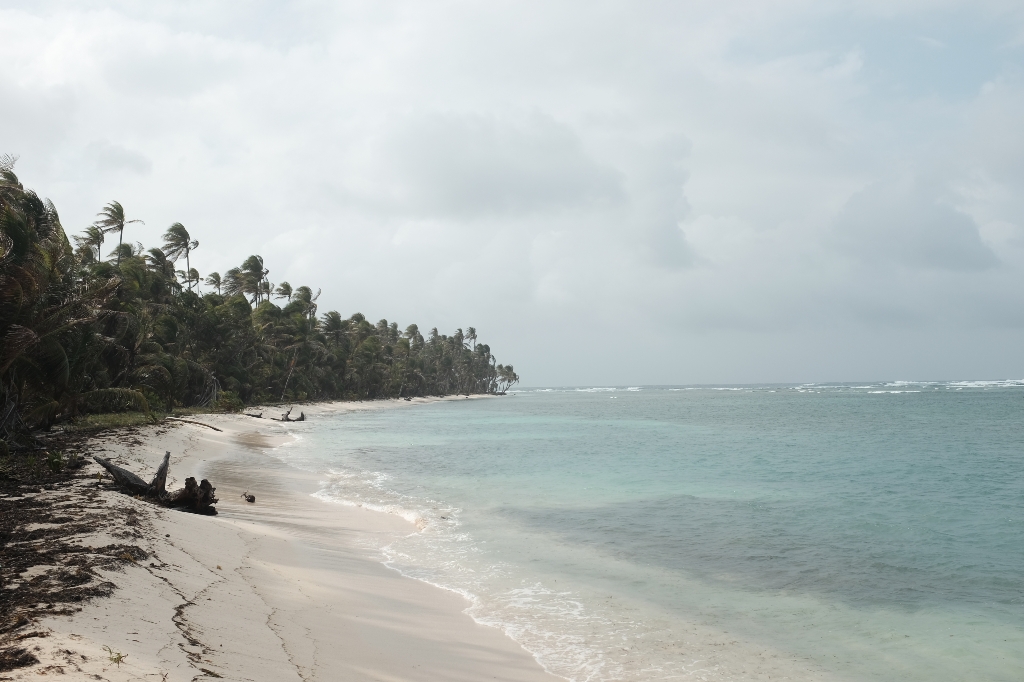
Right by the beach!
Eventually, though I found myself on a sailboat in Cartagena. I figured it wasn’t that much more expensive when factoring in a place to sleep and food to eat for the coming days. Plus, I’d always wanted to try a multi-day sailing trip like this as a way to gauge how well I’d handle an extended sailing trip around the world. The first full day underway I immediately began second guessing this idea as the boat was tossing and rolling and heaving. I kept to a strict anti-seasickness protocol of dramamine, staying outside, and laying down. Whenever below deck, in the stuffy air, with no sight of the horizon and your whole world somehow moving about with no visual input, things quickly got worse. On the morning of the second day, having crossed most of the way from Colombia to Panama the sea began to calm down and we awoke on the leeward side of a small island. Things were much calmer now.
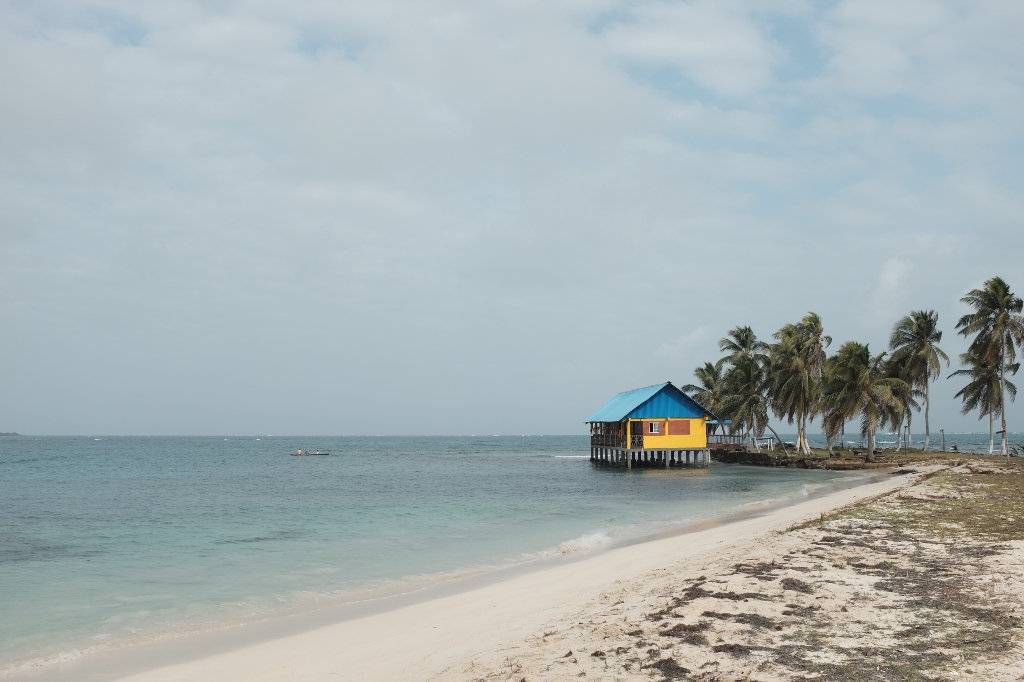
Panamanian customs

The Quest
You could easily gauge how well everyone was fairing by the quantity of conversation during mealtimes. My own personal state ranged from slowly eating a small bowl of pasta and quietly staring into the distance to gregariously eating seconds and thirds like a king. Eventually I think I found my sea legs. It still made sense to just stay on deck but the motion of the ocean felt much more manageable and I once again began to consider doing something like this long term. It was impressive how big the sea felt. Even where we found ourselves, relatively close to land, there just seemed to be an endless amount of ocean that stretched on forever in every direction. Most nights I slept on the deck to avoid the congested feeling below deck. Without a moon in the night sky I’d roll over sometime in the night with a massive sky above me. I saw the north star for the first time in many months. My surest symbol of northward progress in a long while. On the days we’d spent underway I’d set my alarm for 5 AM and awake to an eastern horizon turning from a dark violet to a muted orange eventually giving way to a sunrise.
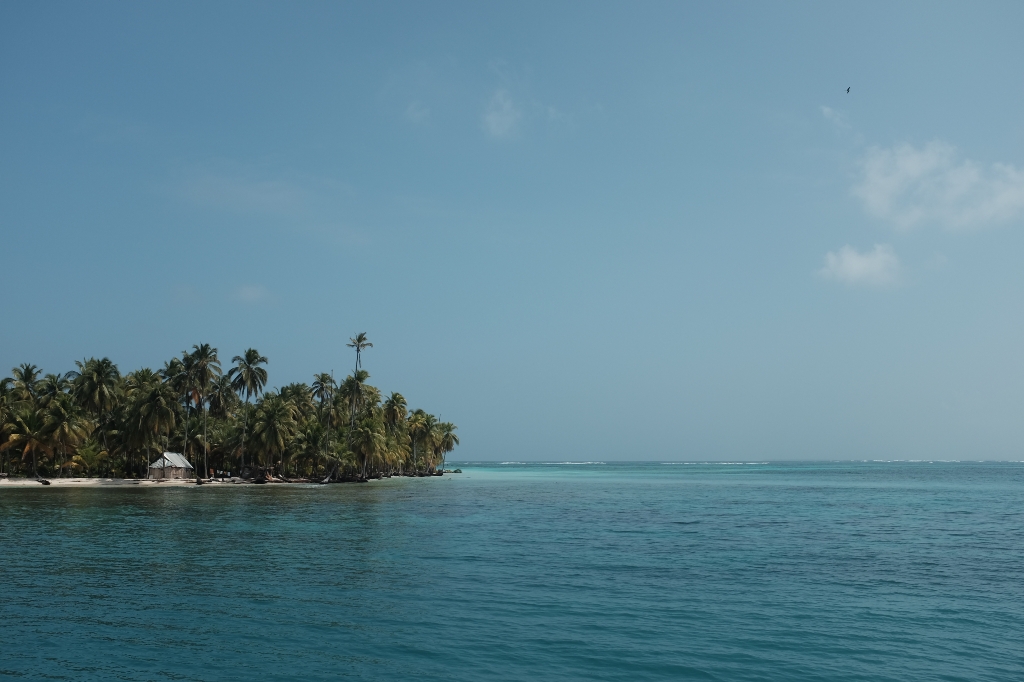
Another nice island
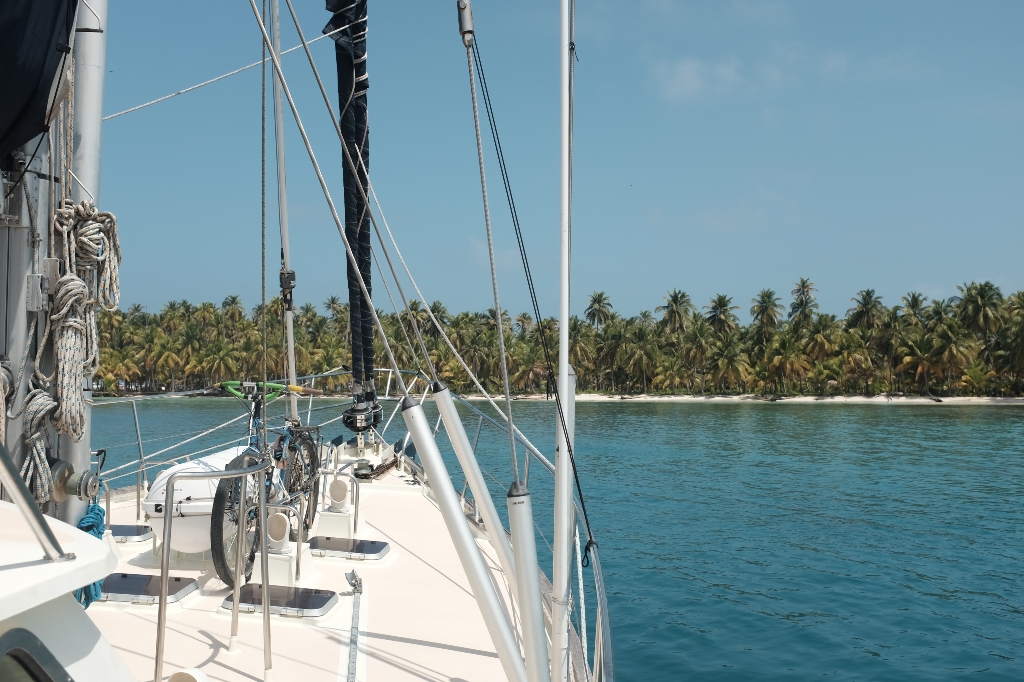
Some calmer waters
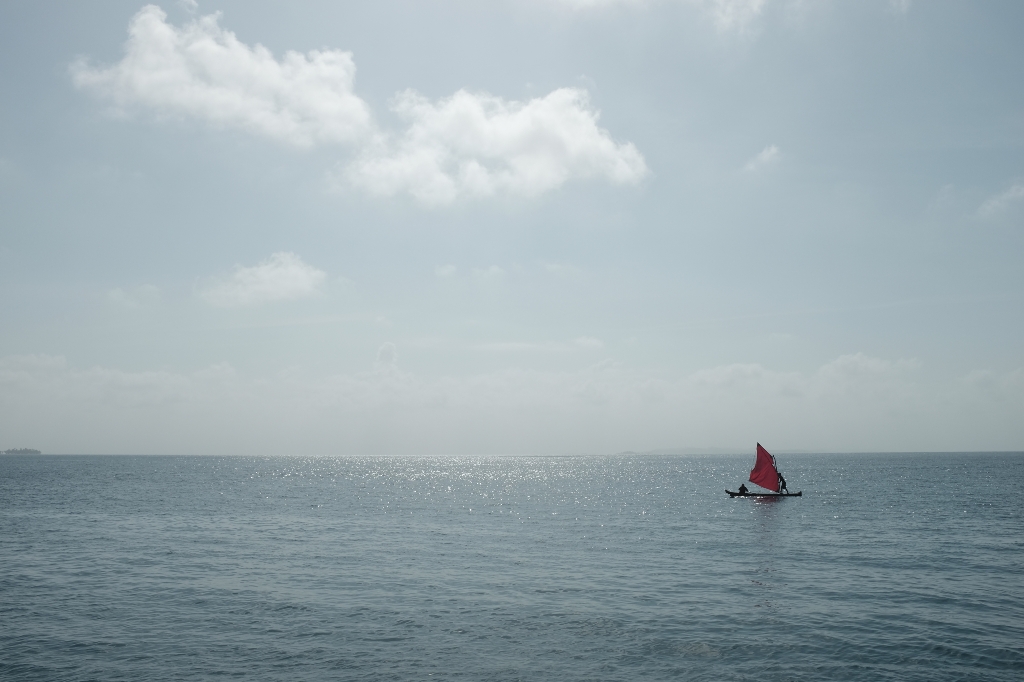
Hoisting their sail
Most mornings or afternoons we’d be at anchor in the calm waters around a small island before crossing for two or three hours to another nearby island. We ate plenty of great seafood, played volleyball on the islands, and swam. We officially crossed into Panama after three or four days between countries. The customs building was on a small island and we went ashore in the dinghy to check-in. It was my first time passing through customs without shoes on.
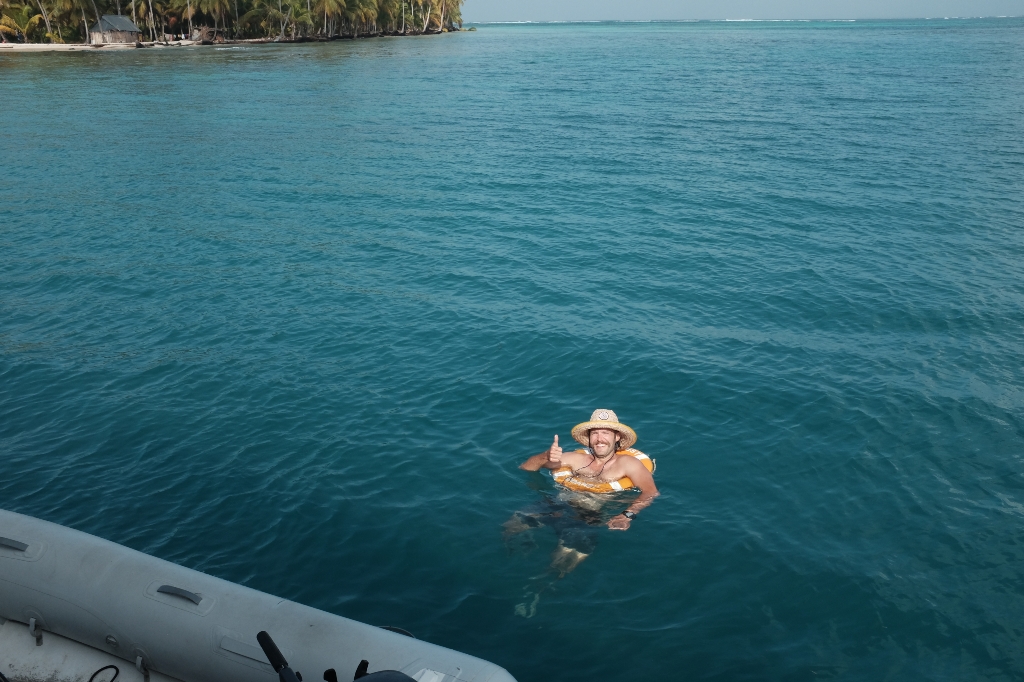
Send help

Sunset on the last evening

A ship graveyard in Puerto Lindo
I’m happy to have taken the sailboat trip as a nice, carefree respite from the cycling. If the people I’ve chatted to during the trip, the local South Americas, have been my favorite part then I also think that that applies to people more generally. But, it is quite humbling to think that we by virtue of our birth, having won some kind of lottery, get to opulently cross this border one way while others are forced to go another way. Eventually we made it to Puerto Lindo, we said goodbye and left the boat for the last time. I had stored my bags below deck but a few metal parts on my bike had superficially rusted while out at sea. The chain was due for replacement anyway so I spent about an hour ashore swapping some parts and refitting everything to the bike. I worked on the patio of a small restaurant run by a Colombian lady and her Dutch husband who was from Delft; small world. I was on the bike once again.

My chain after just five days on the deck of the boat
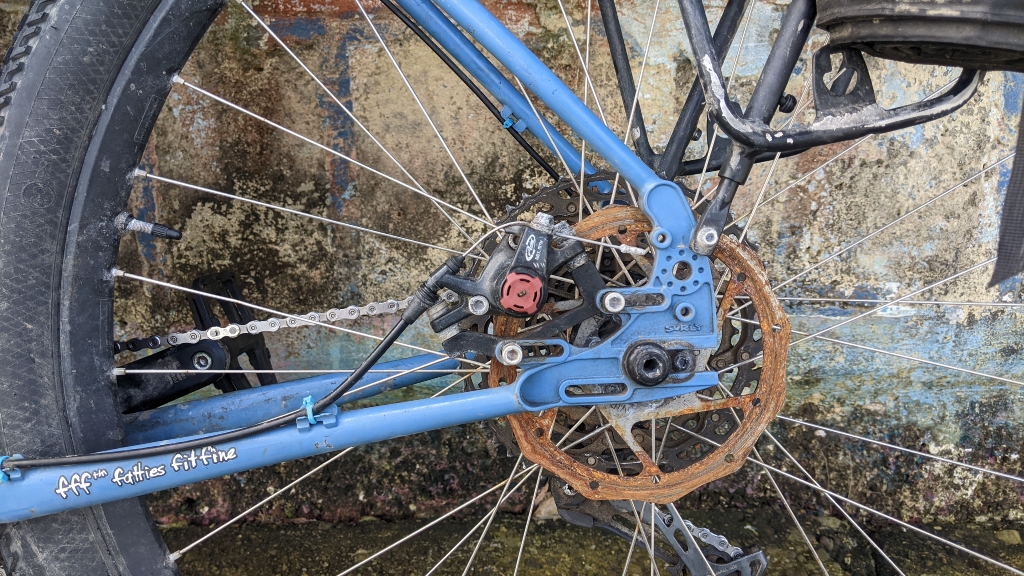
My brake discs
Panama
My first impression of Panama was a wonderfully quiet road from Puerto Lindo to a highway town called Sabanitas. Once out on the main road, what is essentially the highway running from Colon to Panama City, it immediately struck me how much Panama looked like the United States, a similarity I’d see many more times and one I wasn’t necessarily prepared for. I rode over to the fire department and chatted with some of the guys cleaning a truck. They recommended I stop early today on account of it being Fat Tuesday and the roads would be busier and less safe (i.e. drunk drivers). “Go over and talk to the comandante.” The station boss said it was no problem to stay. I could sleep under the staircase in the main hallway. “Kitchen and showers are down the hall.” Jackpot!
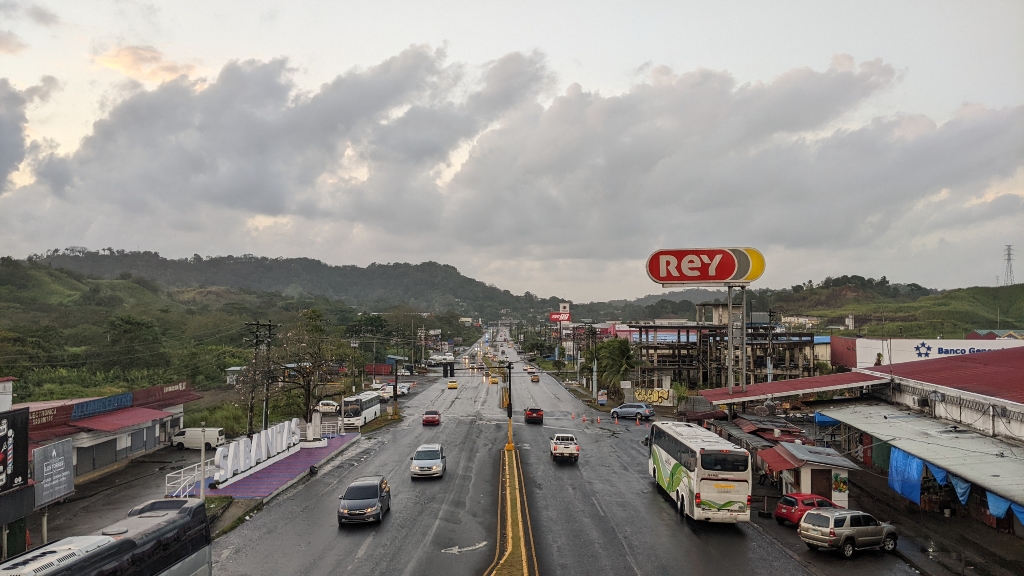
Sabanitas, Panama looking like the USA
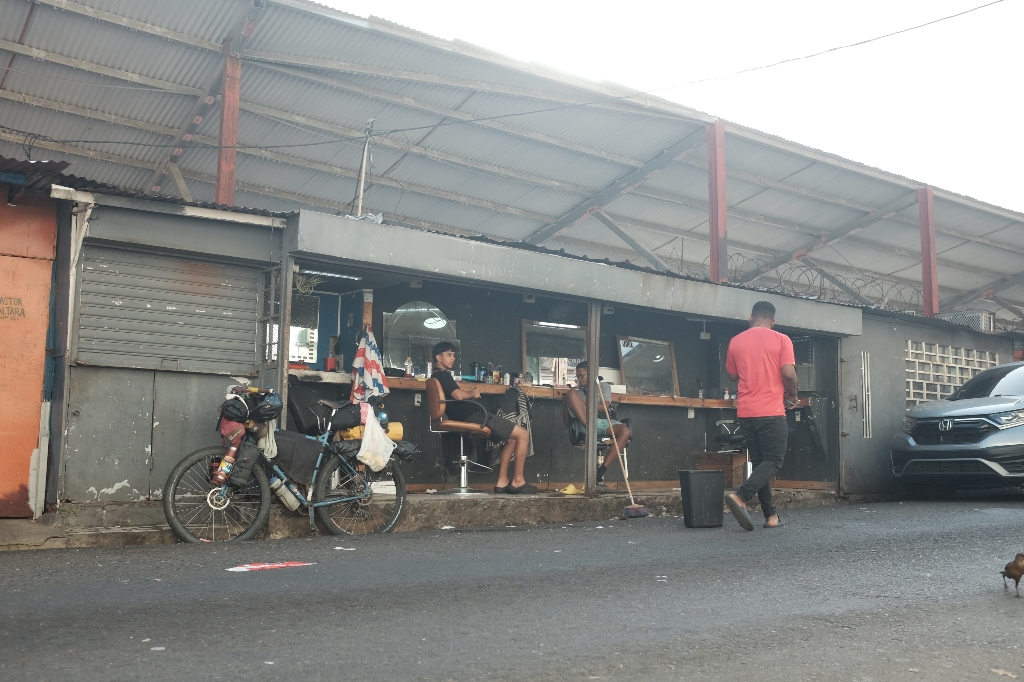
I lost my mullet on the streets of Panama City
I was back on the road early again the next morning. The climate continues to be a difficult factor, especially here in Central America. It’s some of the toughest weather I’ve come across so far. When I’m already sweating at 7 AM as I pack up my camp I often reminisce about the howling winds of southern Patagonia or the nights at -25C high up in Bolivia. Nothing ever dries and everything smells. It’s been difficult to garner any kind of sympathy from those currently living through a northern European winter. One major benefit of Panama being little USA has been the prevalence of McDonald’s establishments along the highway. I’ve found myself audibly howling with joy when cresting a hill in the mid-day heat to see those golden arches in the distance. Air conditioning, WiFi, coffee, and McFlurries. Let’s go!
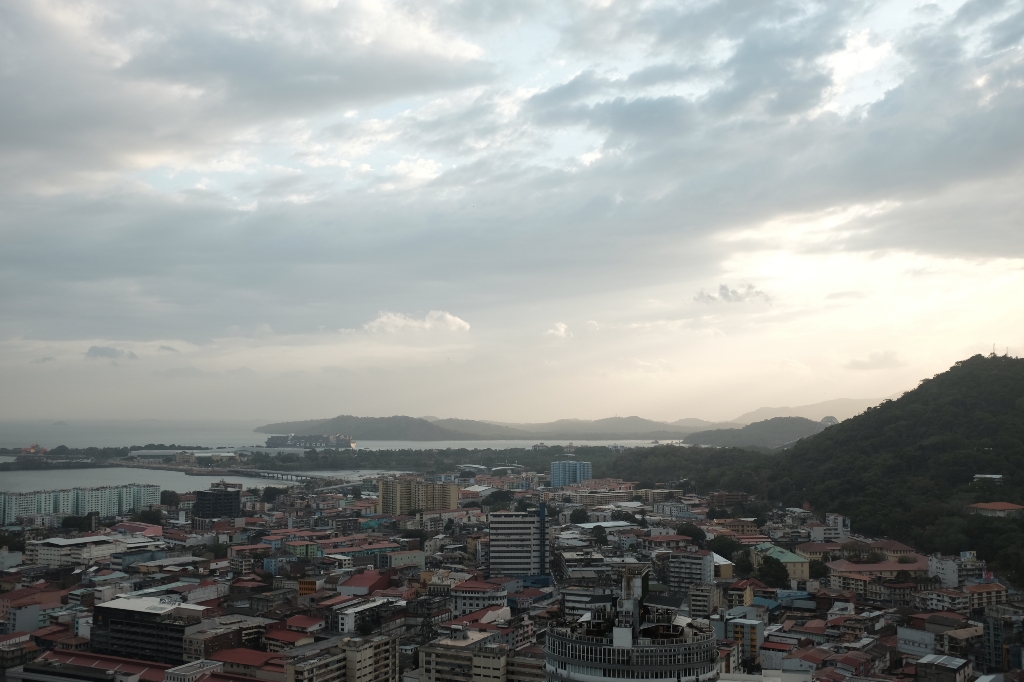
Panama City looking out toward the canal

The other side of Panama City. Vote Willie, I guess
I crossed Panama from north to south in about a day and a half and briefly rode along the canal while entering Panama City. For the next few days I stayed in a hostel recommended by a few other travellers. I found Panama City rather sterile and exclusively built for cars, which didn’t make it feel very welcoming. I spent a day roaming around with a new friend from the sailboat trip, took a walk in the park with some fellow cyclotourists from France and Russia, and ate plenty of ceviche at the seafood market. I shopped for a new helmet and asked about potential route ideas. Because it’s so narrow it seems there’s only one main road that runs the length of the country. A few roads branch off here and there but practically all of them are dead-ends. The map looks like a fishbone, meaning if I’m to make meaningful progress I’ll have to stick to the main road most of the time. Panama City does feel a lot more cosmopolitan than any other city I’ve visited recently. The amount of English speakers is also significantly higher than any place I’ve been in South America. In one bike shop someone asked me what my impression of Panama was, I somewhat instinctively said it was nice to which he replied, “Really?!” This didn’t seem like a good sign.
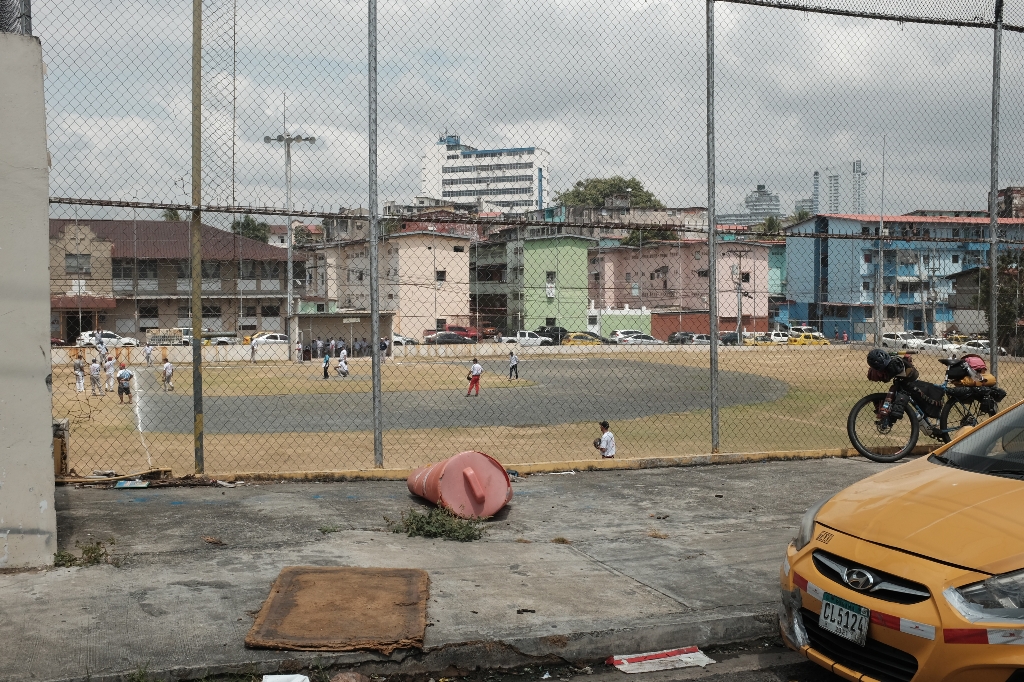
Central America is a big fan of baseball

Many thanks for the ride amigos!
One morning back on the sailboat, while going ashore in the dinghy, I misjudged the depth of the water at the beach and went for an unexpected swim. I had my phone on me but it seemed fine so I didn’t think much of it. Eventually I began to notice problems, though and I figured I’d just keep using it as long as it kind of kept working. I left Panama City late one morning and hit the road. Again, the country appeared to be 100% built for cars and I found myself cycling on the highway. Cresting one climb the phone died completely. I went to a nearby shop and the owner took the phone apart and showed me some short-circuited parts on the main board. Only twenty or thirty kilometers from the city, I figured I’d turn back and figure something out from there. That night, after saying bye to some people in the morning, I was back in Panama City. The next day I found a new phone and got ready to leave again the next day. This time, though, I’d leave together with a German/Spanish couple that could give me a ride out of the city as they started their van trip from Panama to Oregon. I was not keen to try riding on the highway again. Gracias amigos!
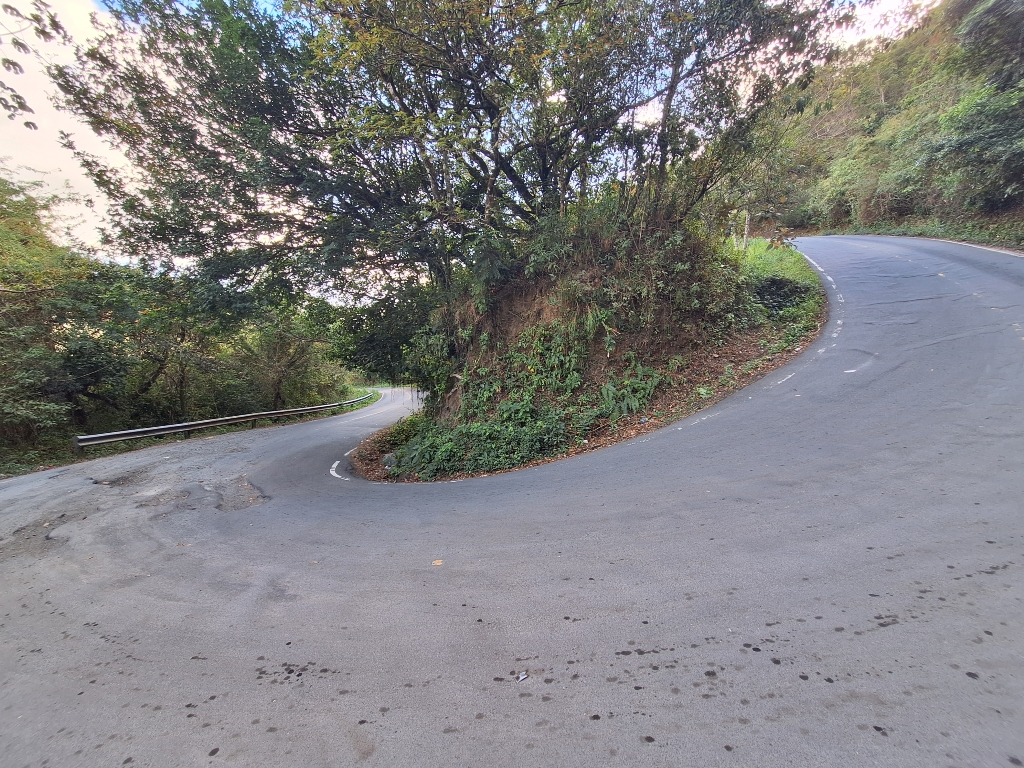
The steepest roads I've ever seen
We parted ways in a town called El Valle de Anton where I began riding again. I was immediately introduced to the steepest roads I’ve ever seen anywhere. They may not be long but the climbs in Central America have proven to be short, punchy, and very steep. None are too long or sustained like in South America so you also never really escape the heat, unfortunately. But after that climb the road opened up to a nice, high lying plateau. As has consistently been the case I much more enjoy the countryside and the friendly folks that live there compared to the big cities. I had a wholesome interaction with a lady selling oranges, got loads of waves and thumbs-ups from people waiting at the bus stops and it was just one of those stretches where you’re riding a gentle downhill with a great view, it’s finally cooling off and the sun is setting and everything is perfect. I came across a public pool and asked the neighbors if I could camp under the roof nearby, which was not a problem. I cooked some dinner, ate some cookies, and listened to the rain come in.

And then a downhill section where everything was perfect
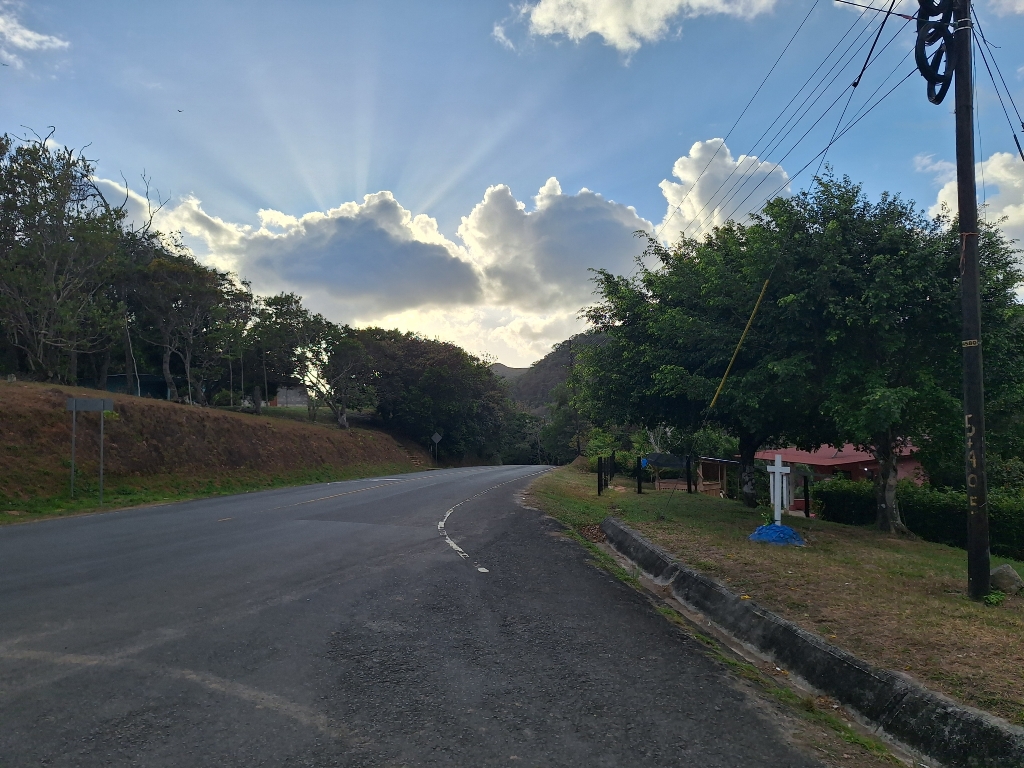
Looking for a quick campsite before sunset
For the first time in a while I met a few other cyclists on the road. This was probably fostered by the fact that there’s really only one road running from east to west. The first was Zian and Guillemette. Zian had cycled south from Alaska so we had plenty to talk about. They met on the road a few months back and had been riding together ever since. They bought me a juice and we shared a brief break in the shade on the side of the road. A few days later I met Miguel from Mexico City who had cycled from there to eastern Panama and was now headed back home. We camped together at a church and parted ways the next day as I turned left down toward the coast.
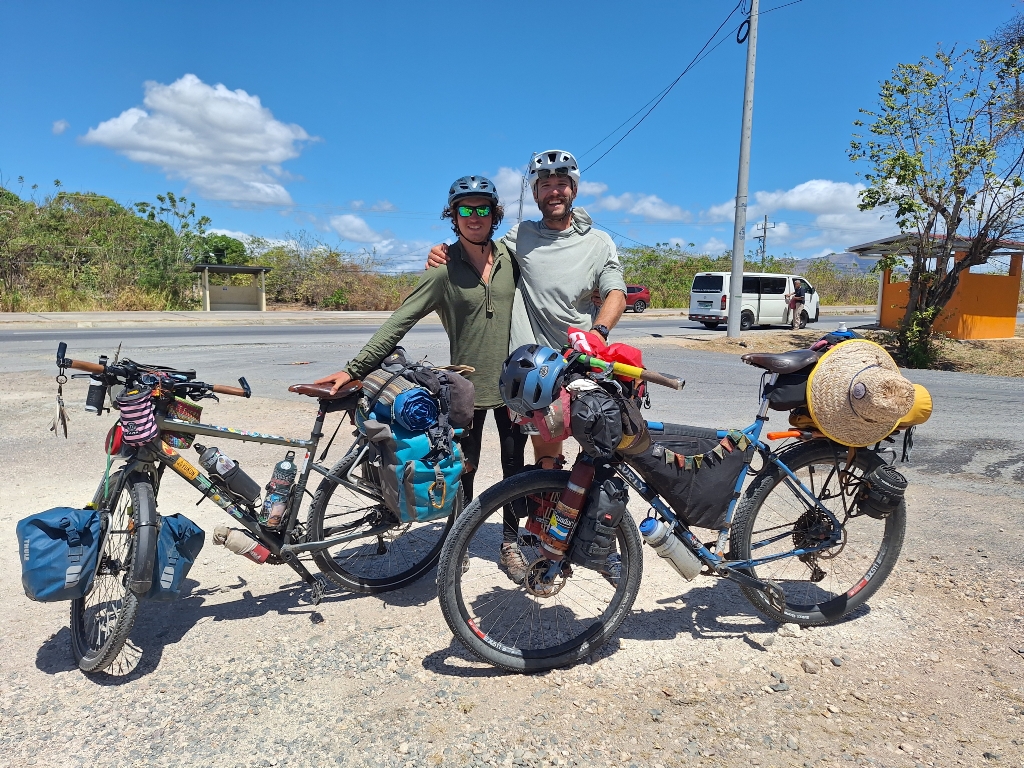
I met Zian cycling south from Alaska together with Guillemette
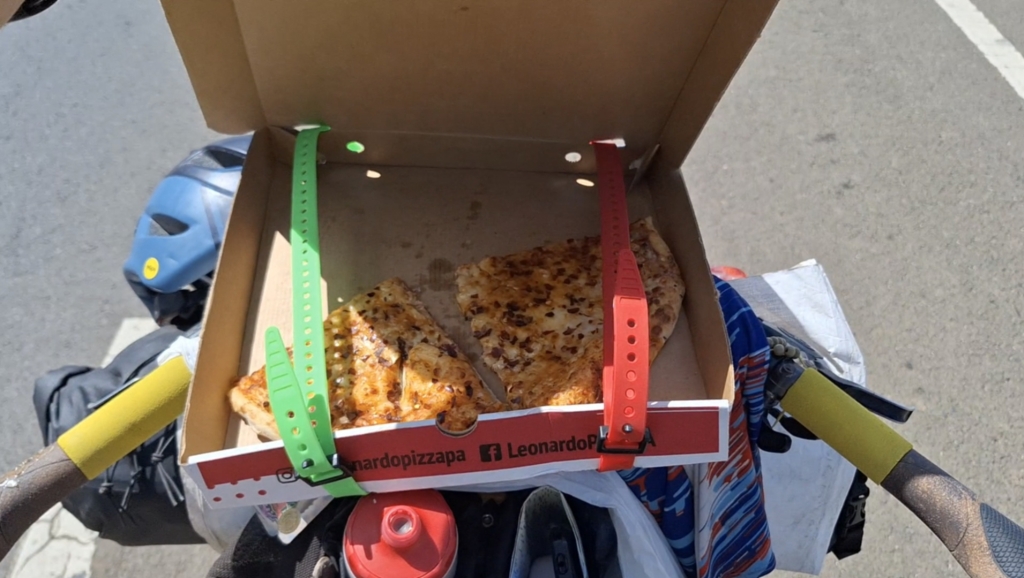
Being a cycling innovator in Panama

Pastor Pedro's church driveway campsite
A few other travellers had mentioned some nice campsites near Boca Chica and I was curious to swim in the Pacific Ocean. It was already nearly sunset by the time I turned off the main road so I didn’t have a lot of time to find the campsite. I rode along some quiet dirt roads that rolled down toward the coast. Eventually I was riding in the dark and wondering if the site would ever show up; I had a point marked on my map and figured there must be something but riding in the dark following a little headlight felt lonely. But then you begin to see a few other people here and there and before you know it you’re eating fried fish and drinking a cold beer reflecting on how quickly your own perceptions can go from “where am I going?” to “hey this is pretty nice!”

A beautiful campsite near Boca Chica with a full moon rising over the bay
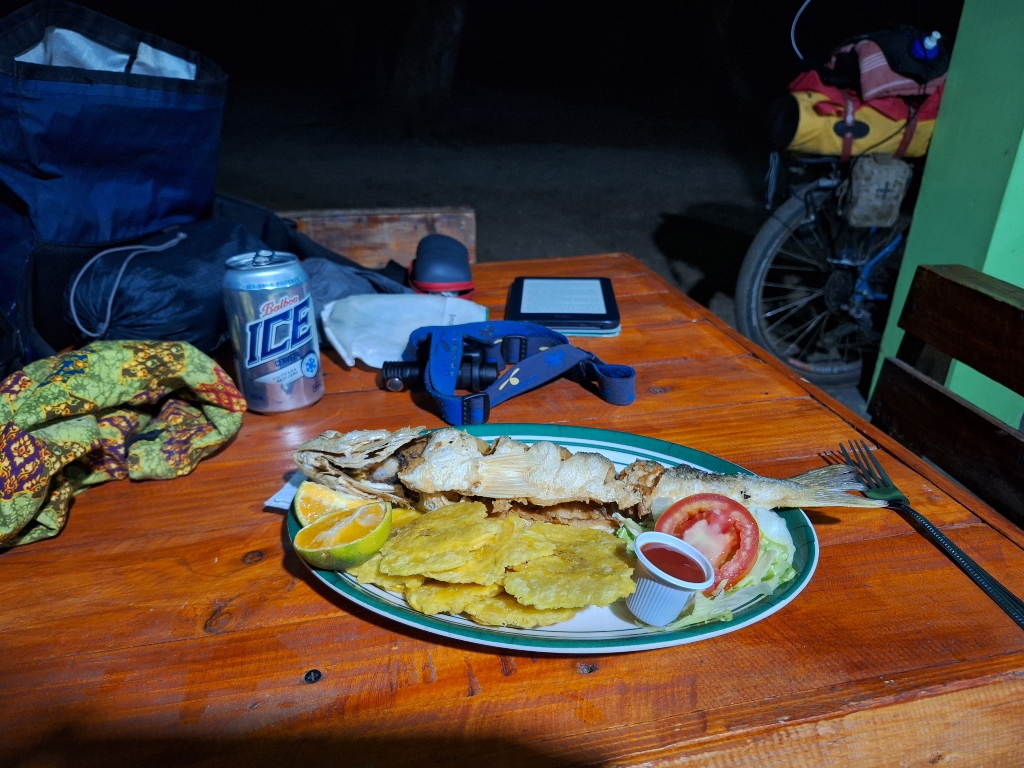
How fast can things go from bad to good?
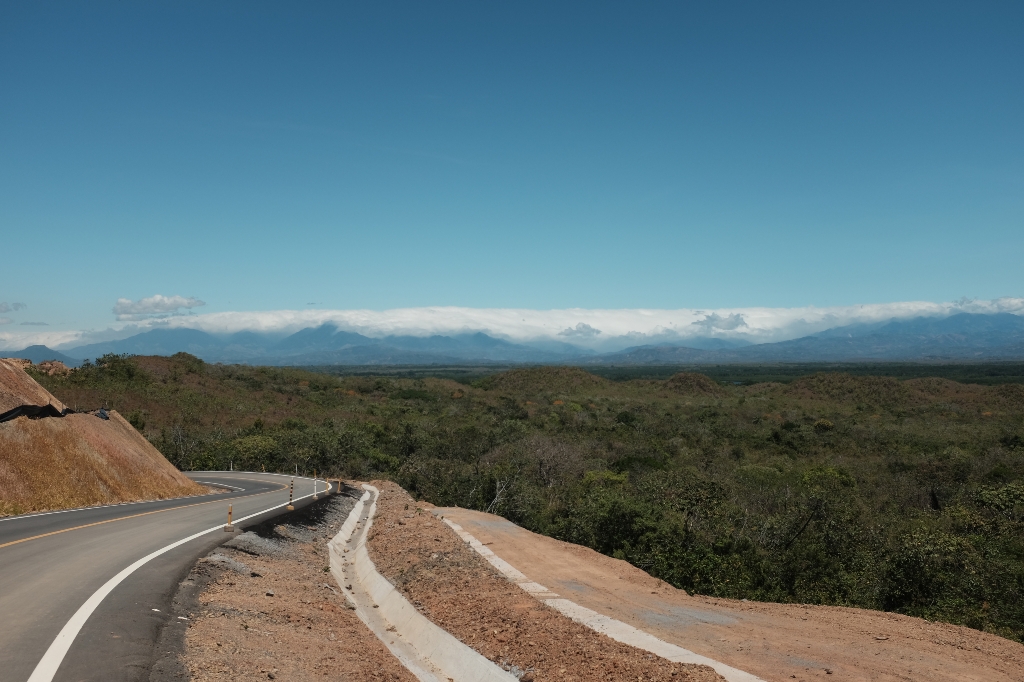
Clouds rolling over the mountains
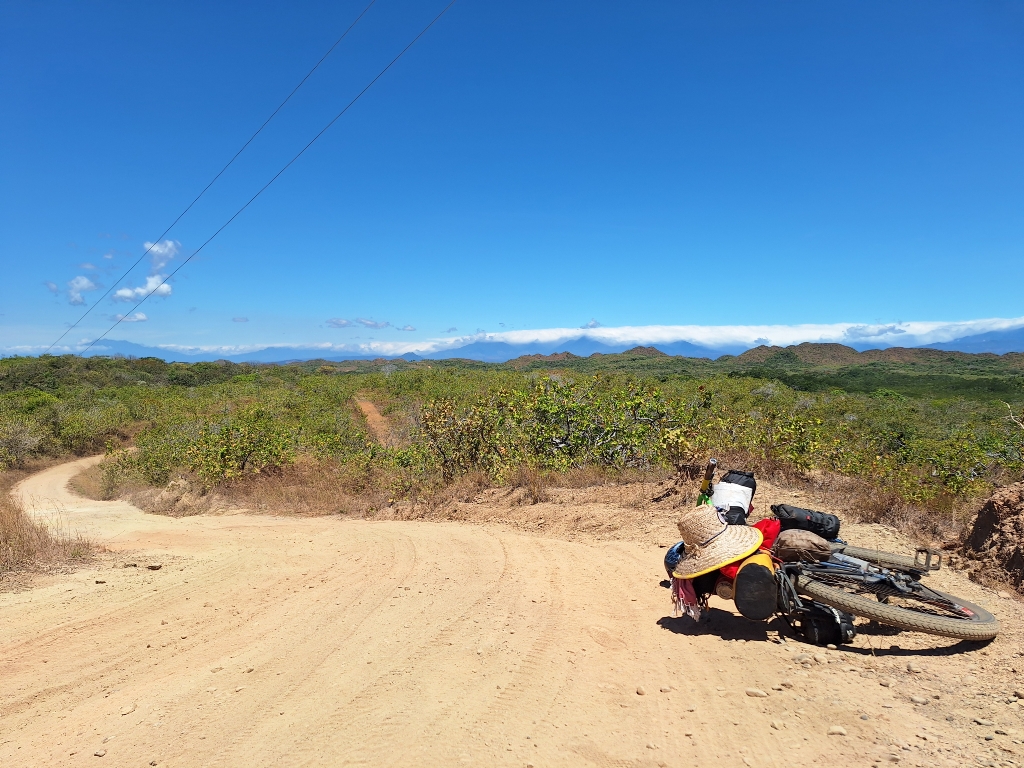
And a dusty section
After just one night there I had a slow, easy morning and headed back up toward the main road. I ate some lunch at the main intersection and ambitiously bought an entire watermelon. I wasn’t able to eat the whole thing then and there and surely didn’t plan on carrying it. I shared it with some cops and asked about the road up ahead. I didn’t have too far to go that day and was almost near the city of David where I’d stay with a family I’d met via the Warmshowers website. I took a rest day with the Martinez family and we spent the day chatting about nearly everything. I was now fairly close to the Costa Rican border and not sure if that country would also be so similar to the USA. I visited a grocery store near the border and stocked up with another massive jar of peanut butter before crossing over to Costa Rica.

Warrior of Christ cell phone repair and barbershop

Travieso waiting for me to wake up
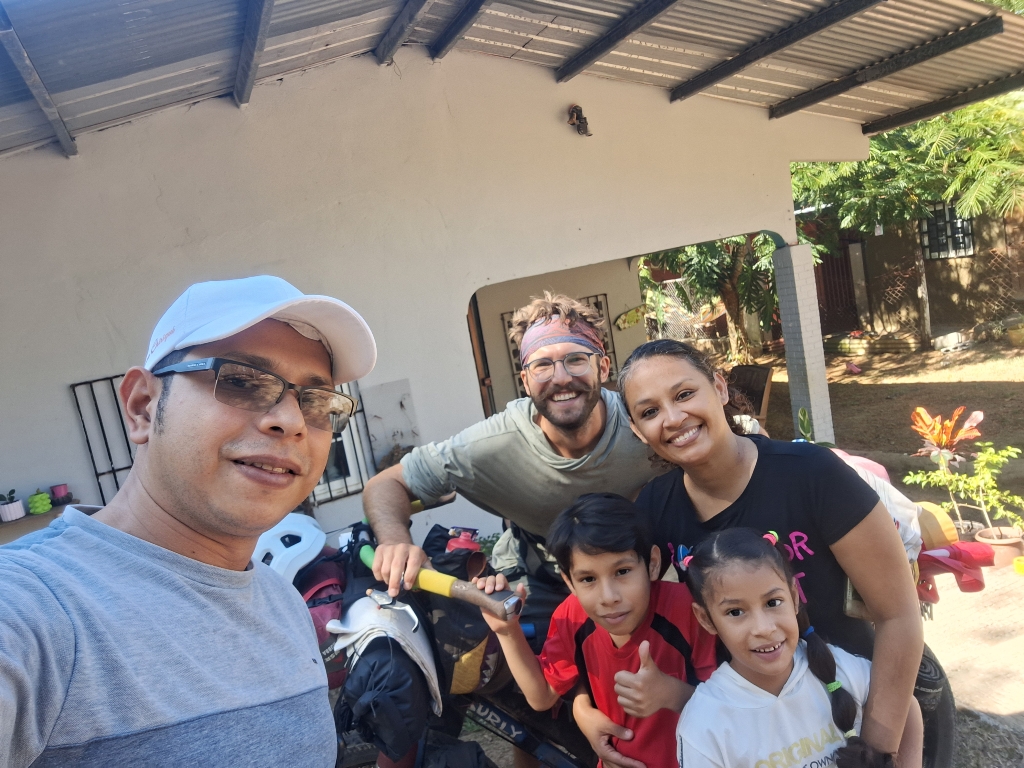
Many thanks to the Martinez family!
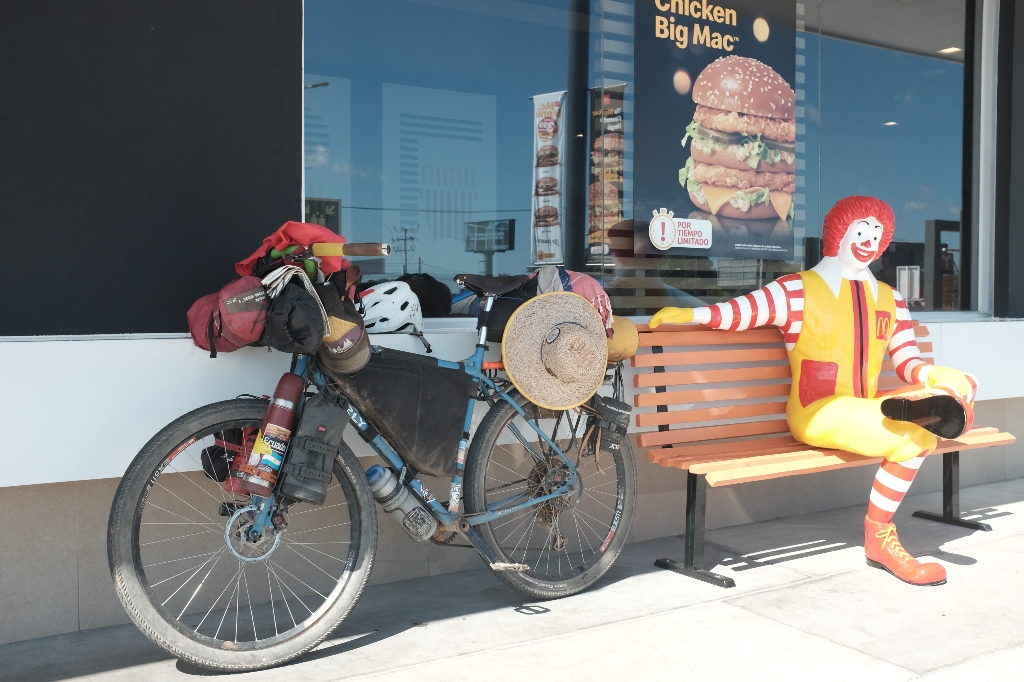
McDonalds, a favorite rest stop for air conditioning, coffee, and WiFi
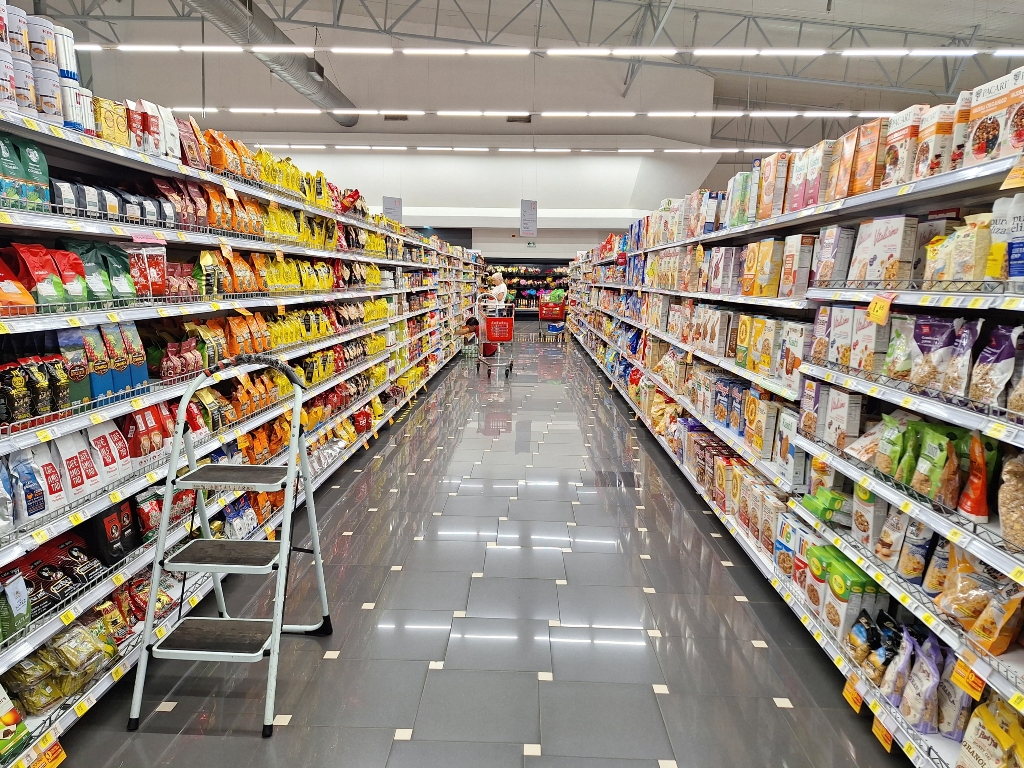
You'd liken yourself in the USA. Chick-fil-A sauce on aisle 9 had me hyperventilating
Costa Rica: www.we-sell-paradise.com
The URL in the subtitle above was my working title for this post; it’s the web address for the real estate agency Remax in Costa Rica. I imagine they see it as a nice, catchy slogan for the services they provide but for me it began to encapsulate many of Costa Rica’s negative aspects. I had crossed the border with Panama at Paso Canoas a few days ago as I was riding along a road leading to the Osa Peninsula. There it was, a giant sign reading “WE SELL PARADISE,” a sentiment that stuck with me for the remainder of my time in Costa Rica. It is a beautiful country with friendly, easy-going people but at the same time it feels as though the whole place is for sale and everything is monetized. I get that people need to make a buck but this place was in overdrive, especially so when compared to the other places I’d visited on my trip. Admittedly, it could be that cycling along the Pacific with it’s natural beauty and huge amounts of biodiversity make it an attractive place for foreigners to buy property and that had I gone more inland or to the Caribbean side then I may have seen a different side of the country. Oh the woes of travelling by bicycle.
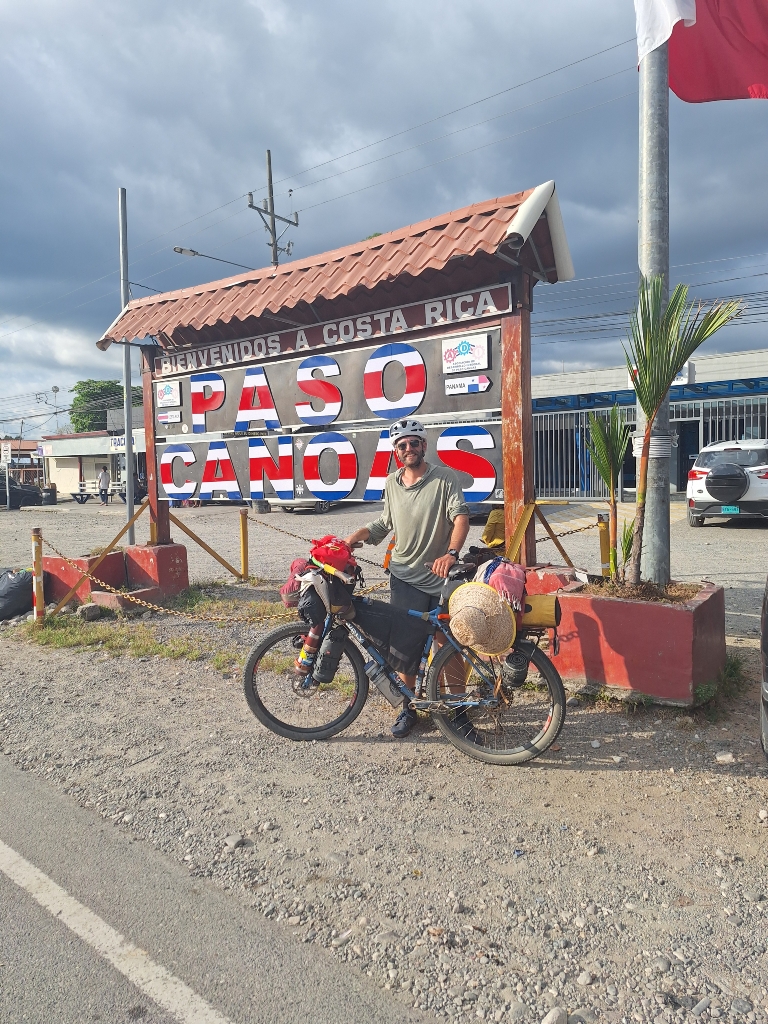
Here we go Costa Rica!
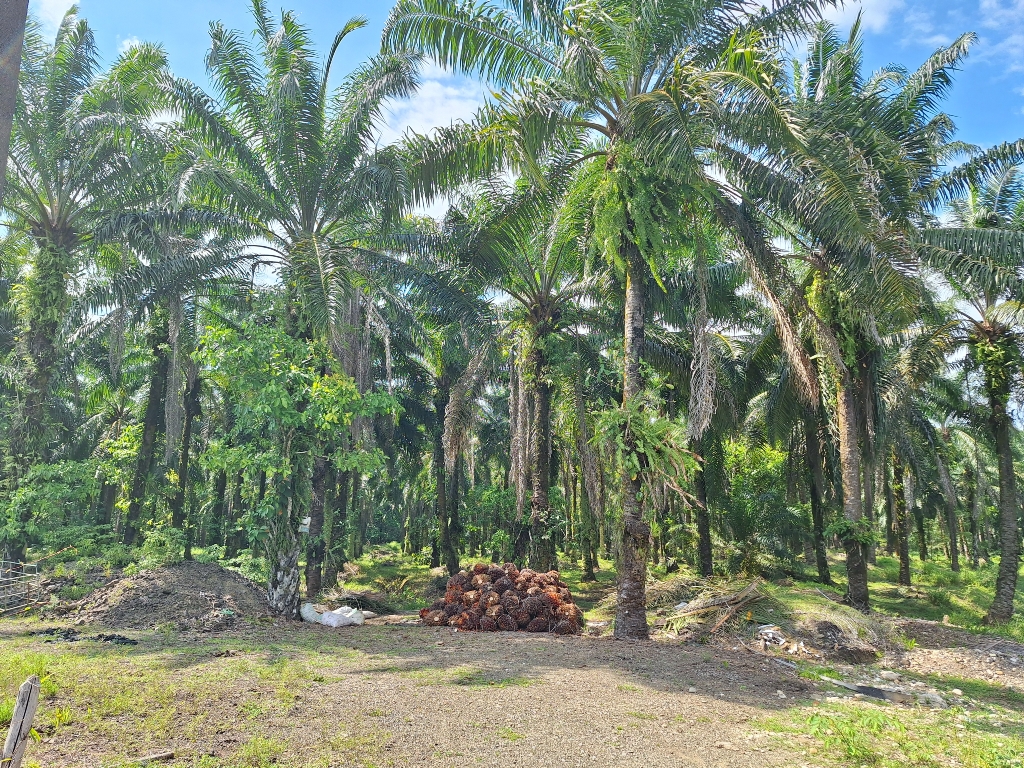
The infamous palm oil plantation

Some more island hopping
My first night in Costa Rica I met a few other cyclists and we shared some rooms at a small hotel and compared notes from the road. The next day, I rode to the town of Golfito and took a boat from there to the Osa Peninsula. Our boat arrived late in the afternoon, I repacked my bags and went looking for a campsite. I found a small dirt road turn-off with a small horse farm and asked the owner if I could camp on his land. That wasn’t a problem and I was shown a nice spot behind the corral. I was invited to come sleep inside but declined because I was after all just some guy off the street; in the field would do just fine and we both agreed that that’s probably best. A few minutes later the owner brought me out some dinner. I packed up early the next day and hit the road again.
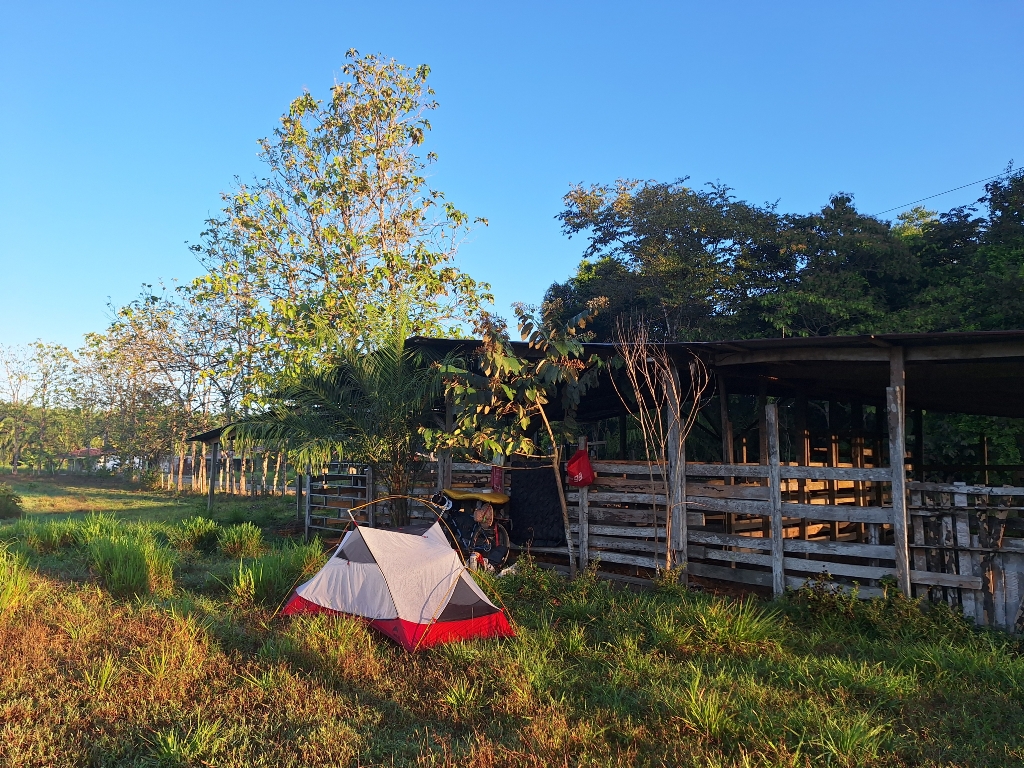
Camped out behind the corral on Avilio's farm

Some nice rivers for swimming on the Osa peninsula
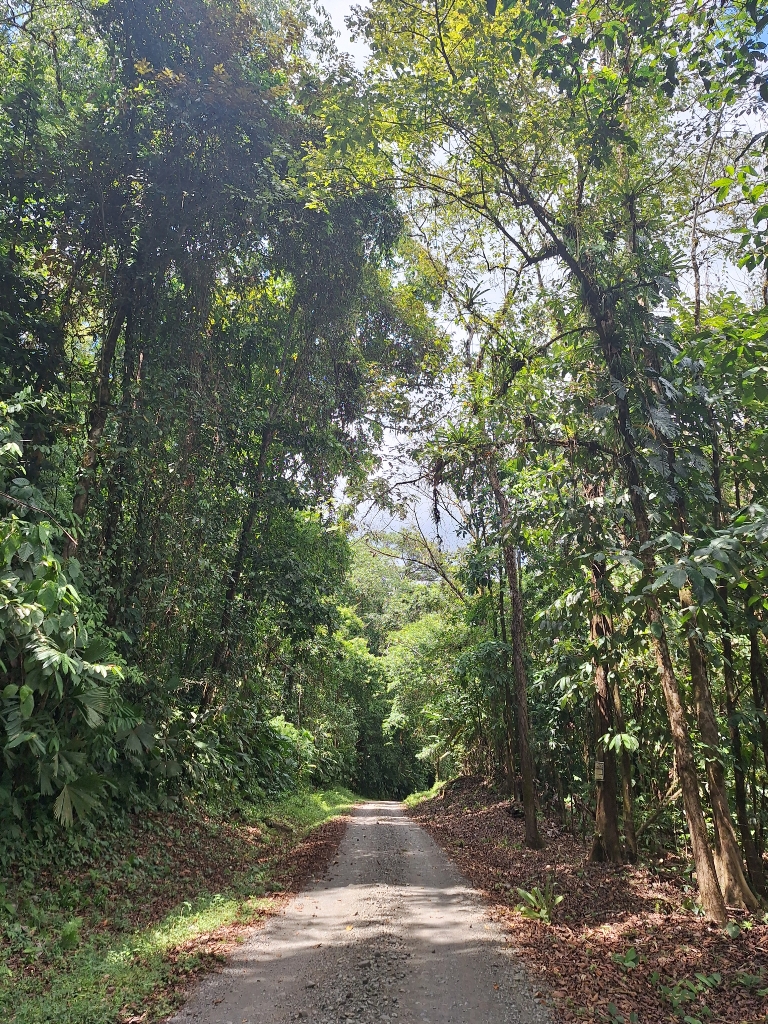
And a nicely shaded forest
My goal was to just ride across the peninsula and appreciate its nature; it’s known for its staggering levels of biodiversity. I’ve often reflected on how loud life is in Latin America and even the bugs and birds seemed to be screaming in these woods. Every so many kilometers I’d take a break in the shade and just stop to listen; at times the volume of the bird calls and all of the little critters seemed absurd. I eventually made it to a nice campsite on the beach just in time to watch the sun go down. In the morning I chatted with an older Swiss couple also camping nearby in their truck. My original plan was to take another boat from a small port nearby back to the mainland; it offered a nice view from inside the mangroves and would be a quick ride back to the main road. One of the Swiss guys who spends his winters in Costa Rica convinced me the road back was also a nice option with good views and it was only 40 kilometers or so with a small river crossing at the end. Besides, the boats are unreliable and it’s never certain whether or not you can take your bike. That’s the last time I listen to car people.
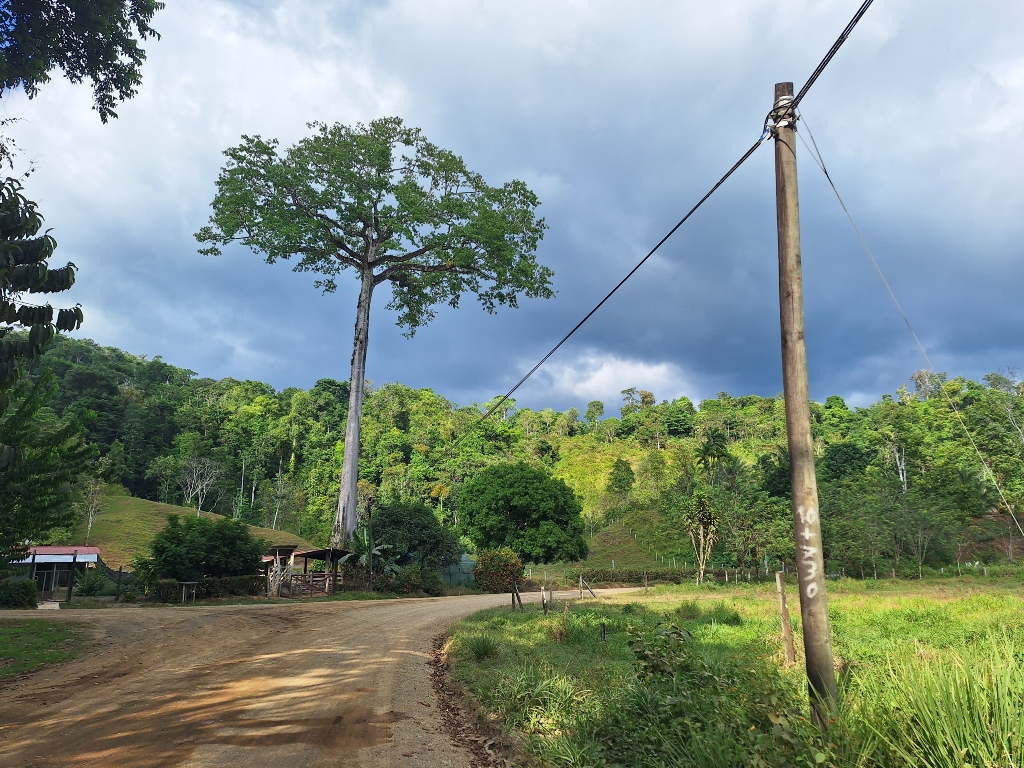
A really, really big tree
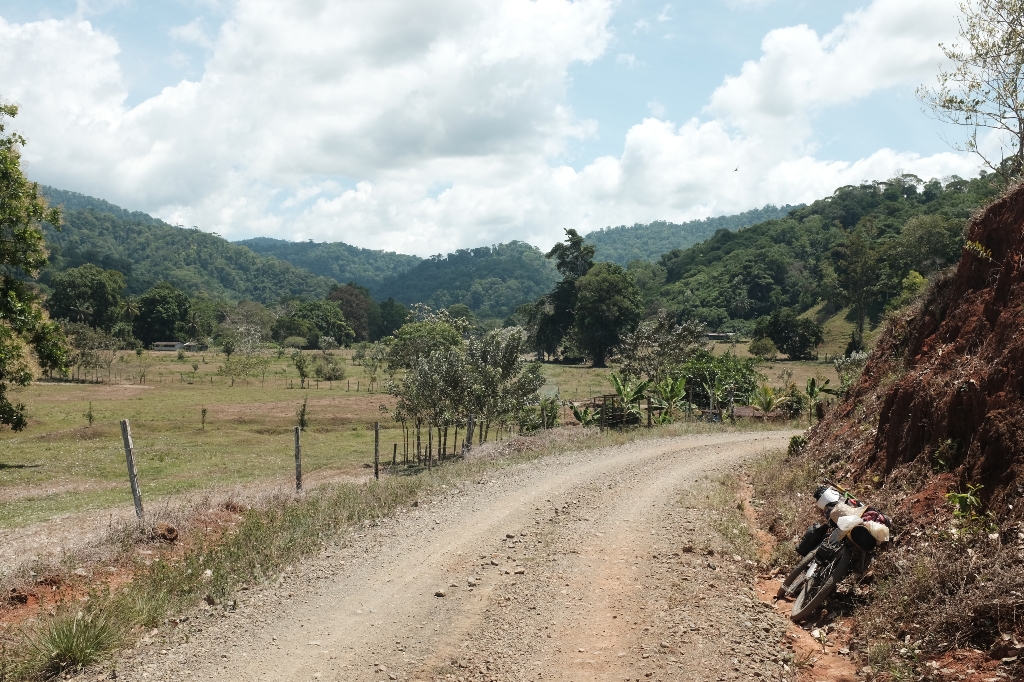
Another quiet and beautiful section

My first coconut!
I had an easy morning, ate some breakfast and did some reading. I pushed on a palm tree for a while trying to convice a coconut to come down. No luck. I spent another thirty minutes or so throwing old husks up into the tree. Again, no luck. I went back to eating breakfast and jumped up to the sound of a coconut falling out of the tree of its own accord. I put my machete to use and opened my first coconut. Sometime around mid-day I soaked my clothes in water to keep cool for the first couple minutes and hit the road. For a while, it was really beautiful and then it became really challenging. Still beautiful but also really challenging. It ended up being a really tough day pushing my bike quite often up steep, dusty hills. I made it some thirty odd kilometers and walked into a Pupleria (i.e. local shop) in the town of Miramar sometime around sunset. From what I figured most of the tough stuff was now behind me and it was mainly downhill to the town of Sierpe. I chatted with Domingo in the shop, bought a few snacks, and asked if there was a place to camp. He told me the small community space across the way is nice and covered. I setup up my tent and asked him about all of the coconut trees. He said they were his and I could take as many as I wanted. I slept well and rose early the next day to ride down to Sierpe.
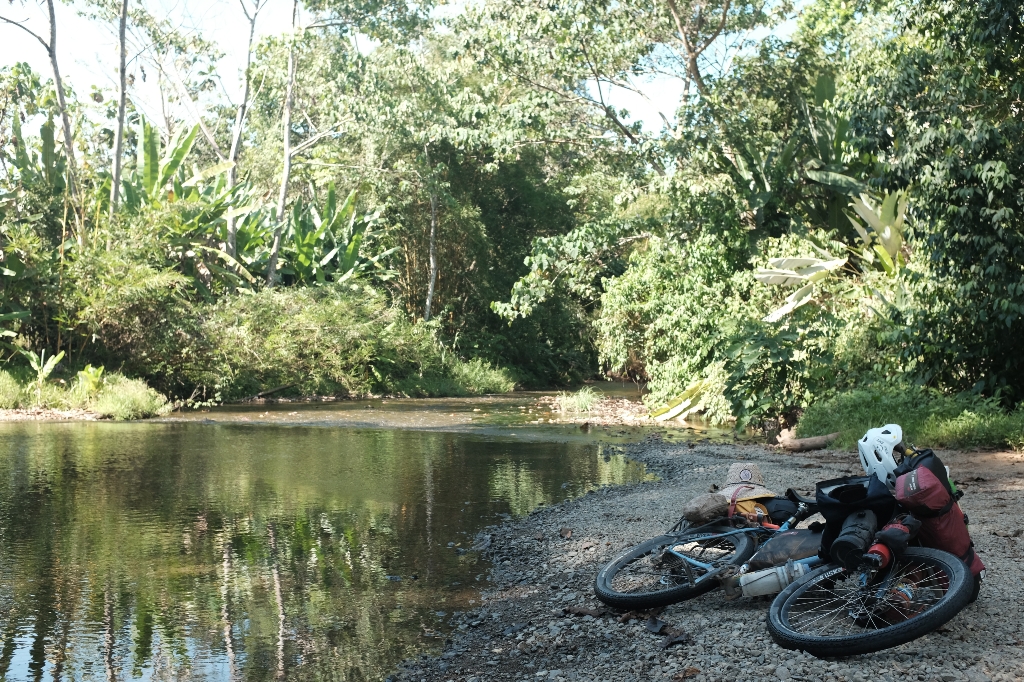
Another shady swimming spot

Nature expressing itself; the appropriately named Fan Palm
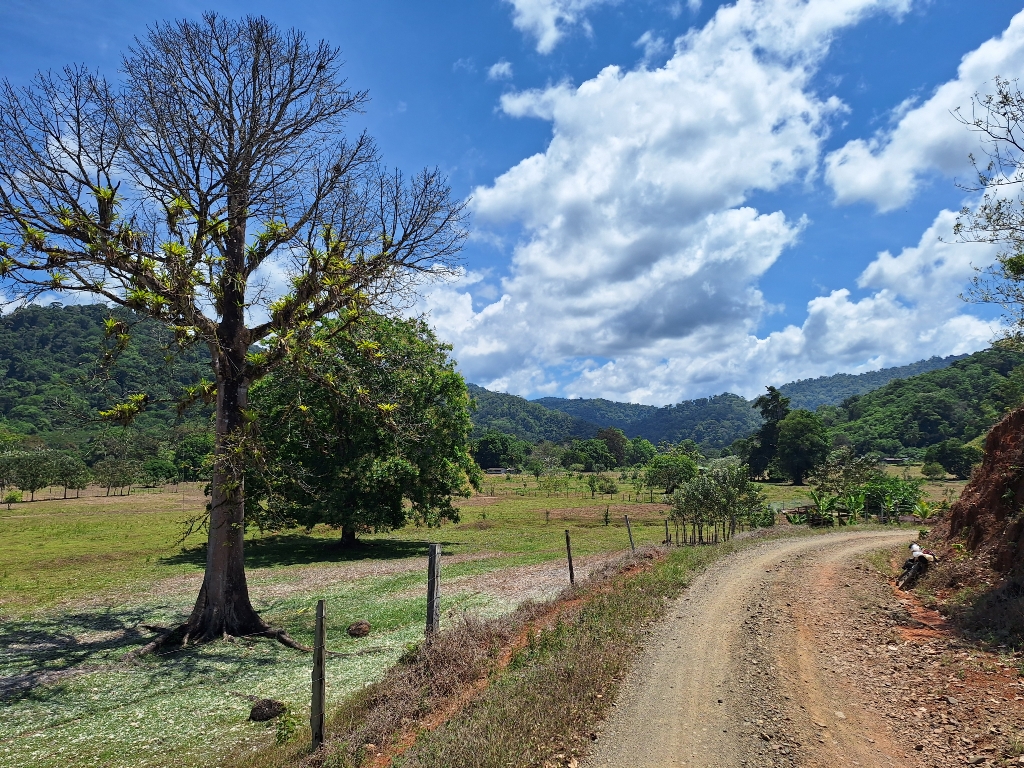
The Osa peninsula before it became difficult

Sunset from the village of Miramar
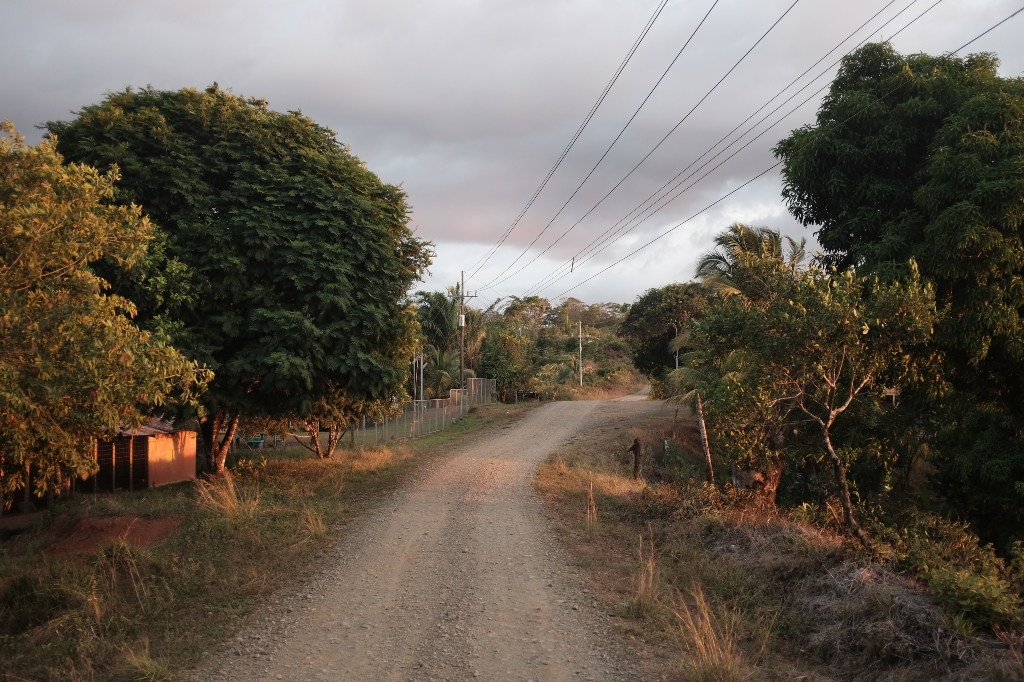
Downtown Miramar
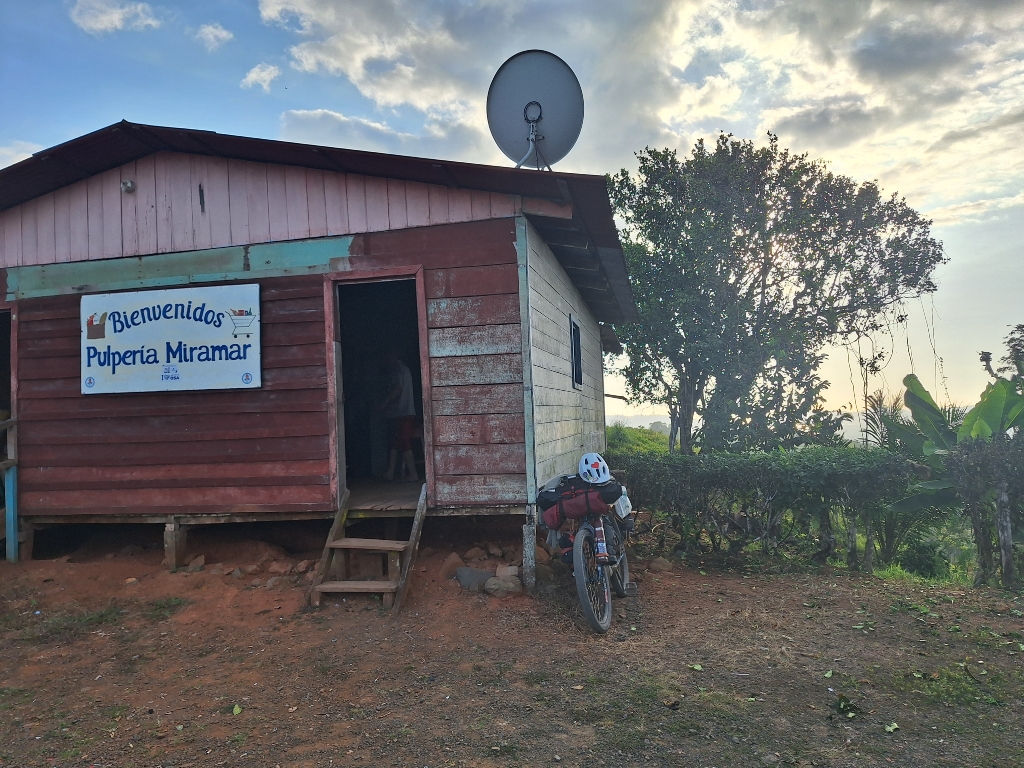
The pulperia where Domingo works
I got to the river and whistled across for one of the lanchas to come pick me up and take me to the other side. Back on pavement I went into town looking for a cup of coffee and to just veg out for a bit. The Swiss folks were coincidentally also in the cafe and the lady shared that, while driving along the road she thought it looked pretty tough for cycling. I admitted it hadn’t been the easiest stretch but we had a good laugh about it.

Crossing the river to Sierpe and done with Osa!

Endurance groceries had me laughing in the checkout line
I rode past massive palm oil plantations on my way back to the main road. It eventually struck me that there were many touristy places in Costa Rica that demonstrated the country’s incredible nature but then while cycling in and out of these places they were often surrounded by huge areas covered in palm oil groves. By now it’s an almost infamous tree for which huge swaths of land are appropriated for its production, eventually ending up in many of our processed foods. As rich as Costa Rica is or claims to be, probably the most expensive country I’ve cycled through so far, these places were often inhabited and worked by people who were by no means rich. I began to see a strong stratification of wealthy areas that catered to Americans and Europeans and the rest. This could often be seen in the palm plantations or in the areas of immense natural beauty. A big benefit of the humble bicycle is that you get to see it all.
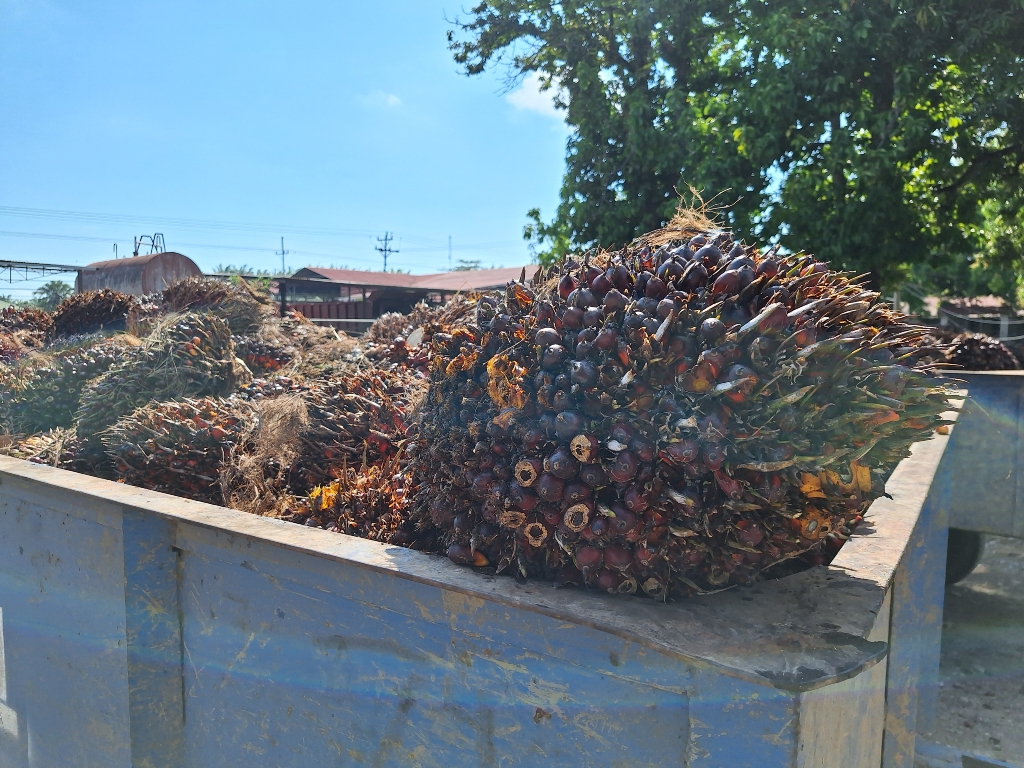
More palm ready for processing
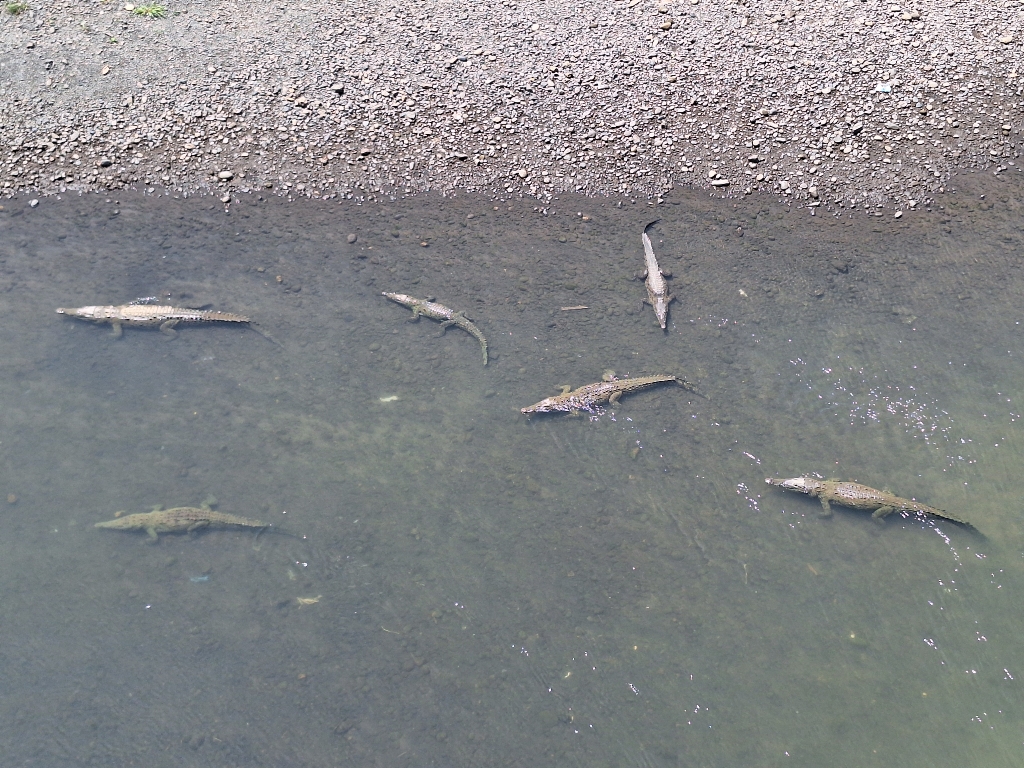
I've been doing lots of swimming but I skipped this river
Once I got to the main road my objective was to ride to another peninsula on the northern Pacific coast. Along the way I passed through a few towns that seemed to be huge retirement communities for rich foreigners. Lots of golf carts and people who simply started conversations with me in English. They weren’t wrong, I speak English, but it’s something I hadn’t been used to in a while. They were consistently very kind and curious and I enjoyed talking to them and sharing about my trip, whatever the language, but something weird about Costa Rica was that it often oscillated between places like this and significantly poorer areas. Rich and poor living near each other but not really coming into contact. I’ve cycled through plenty of developing countries so far that are certainly not rich but in those countries where the mean purchasing power per person is high it also seems as though the depths of the socio-economic ladder are lower and there is a greater prevalance of visible despondency for those less fortunate. As I’ve got plenty of time to just think while cycling this all made for a strange and strong juxtaposition that I still don’t really know how to describe.
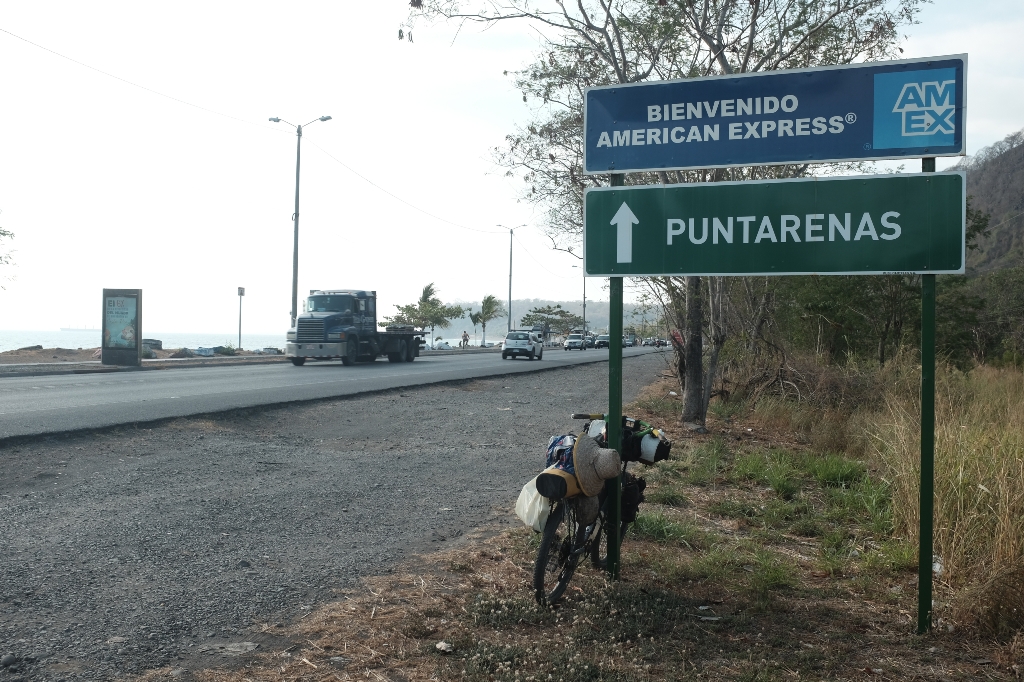
The town of Puntarenas, brought to you by American Express

Edward Hopper-esque Pollolandia with some happy looking chickens
I rode to the town of Puntarenas and took the ferry out to the Nicoya Peninsula. I was originally interested in visiting this place because it’s regarded as a “blue zone” for its statistically significant portion of inhabitants living healthily to an advanced age. There was also a bikepacking route that I intended to follow (link). Sometime in the late morning I arrived in Paquera and rode toward the shore up and over a few ridges. I stopped briefly to ask a man about a place to refill some water bottles. Around the hottest part of the day I took a swimming break in an estuary with a few dogs. I got back on the bike again, having to push a bit here and there on account of the at times commically steep roads. Things had finally cooled off a bit and I rode until a bit after sunset and found a nice campsite. I took a rest day the next day and just lounged around a bit.

Crossing to the Nicoya peninsula this time
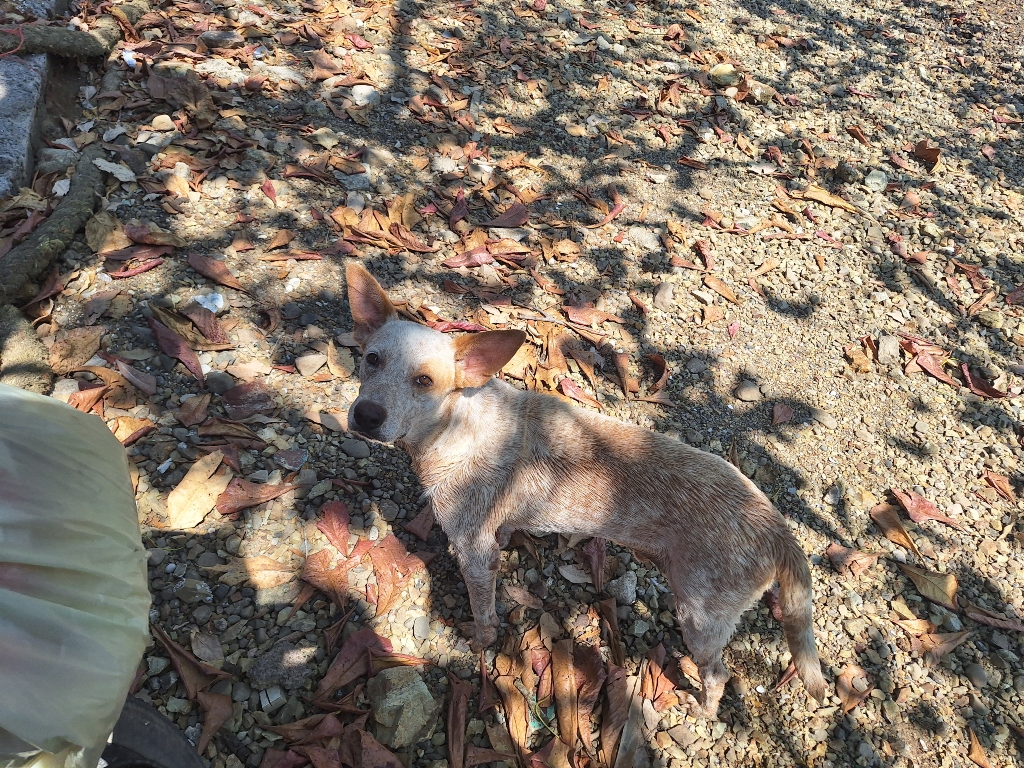
Took a swimming break with this well camouflaged dog

At least I got to ride down this one
My route on the peninsula also allowed for a bit of beach riding but this was heavily dependent on the tide. If it was high then the beach was either mostly underwater or too soft to make any decent progress. I met a local family on the beach who gave me a brief lesson in opening coconuts with machetes and they let me try a piece of germinated coconut, which develops a kind of spongy, sweet cake on the inside where usually you’d find the coconut water. Some days began to feel a little too difficult. Things were dry, the temperatures were high, and the roads were steep. I’d find myself pushing up another dusty hill only to have a nicely air-conditioned rental car come by with a smile, a honk, and a wave. “Look at the crazy bicycle man, honey!” Maybe it got to me more than it should have. But there were also small and big gestures abound that could quickly turn my day around. At one of many river crossings I was taking my shoes off and preparing to push my bike across when some kind people in a truck let me toss myself and my bike in the back. Another day I rode into a small town and got to chatting with a lady who then comp’d my extravagent meal at her family’s restaurant. I ate like a king! I find it humbling to ponder how quickly your day can improve, going from kinda shitty to kinda good with a little help from some strangers.
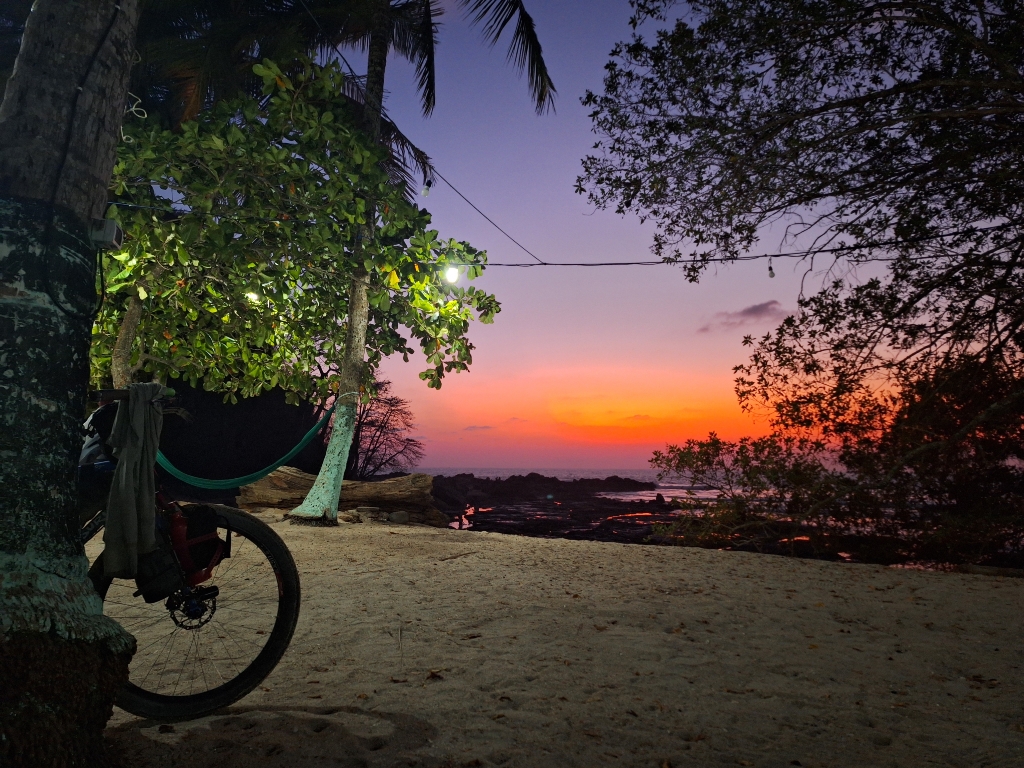
Another fancy campsite
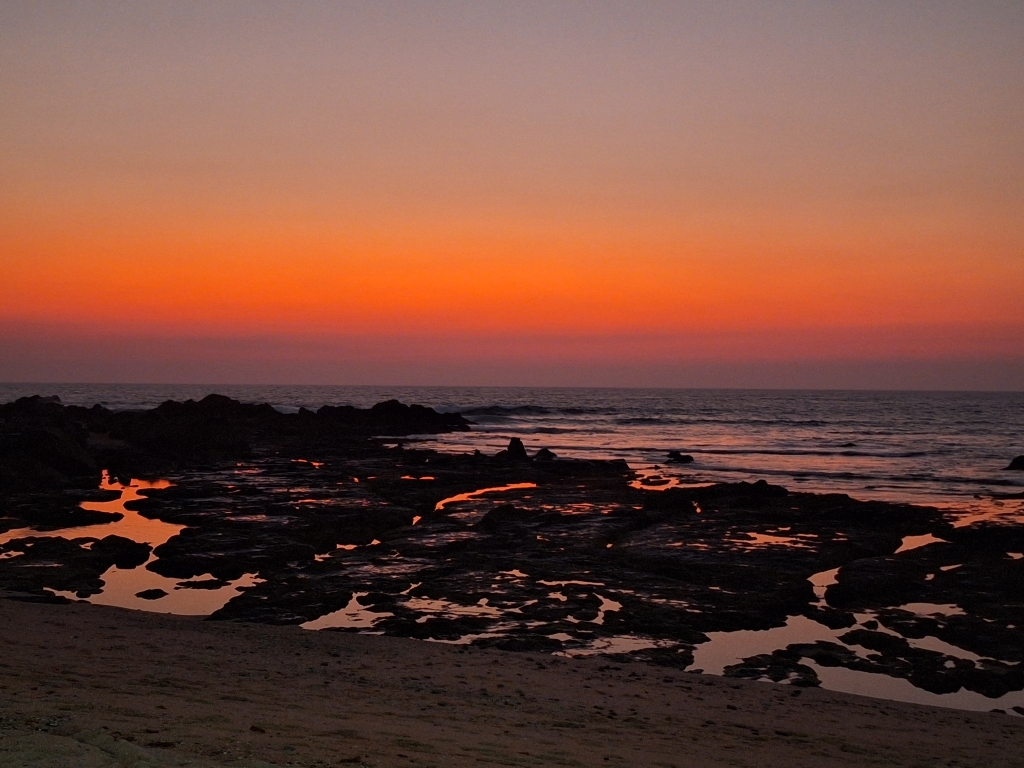
Tide pools and sunsets
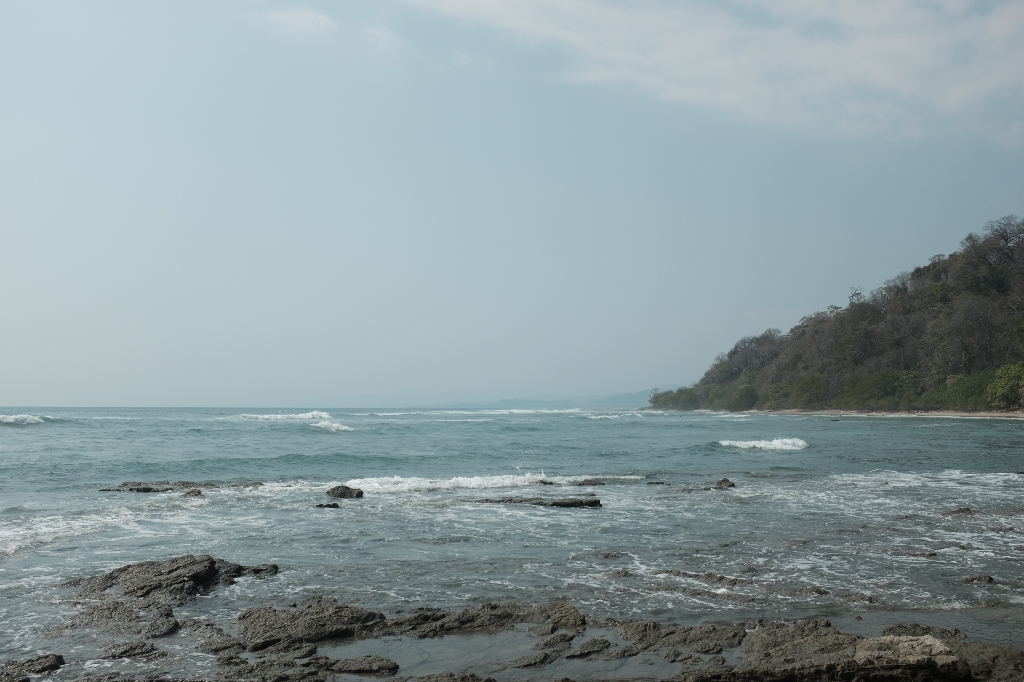
The Nicoya peninsula getting quieter now
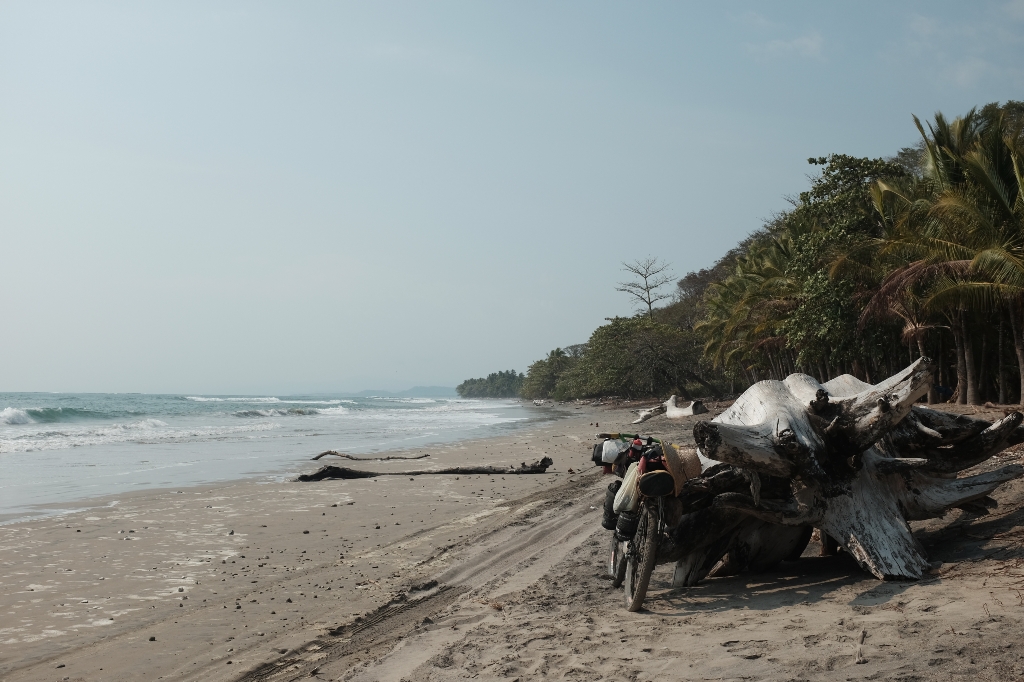
I rode on the beach for a bit
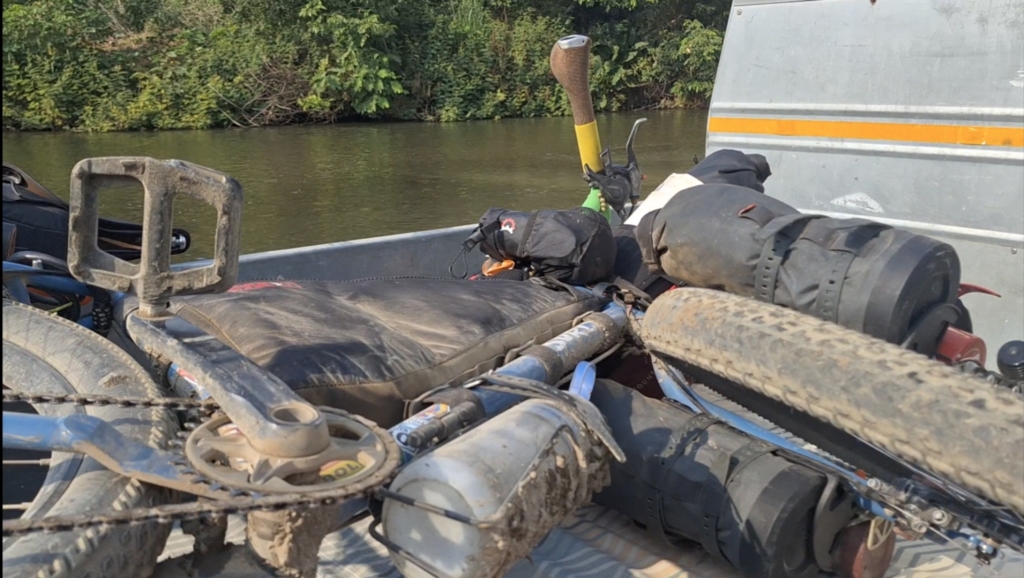
Thanks for the river crossing, y'all!
I spent a few more days riding along the coast of the Nicoya peninsula. I camped in a few more yards, scared off many sunbathing iguanas next to the road, and did plenty of swimming. Eventually I made it to the town of Palmira where I stayed with Diego via Warmshowers. I took a rest day at his place together with a travelling couple. Diego had to leave but told us to lock up and hide the key when we left. I avoided the main road as much as I could while headed for the Nicaraguan border and rode some nice quiet stretches; it felt so much like autumn minus the temperatures of course.

Another fun, fast gravely section
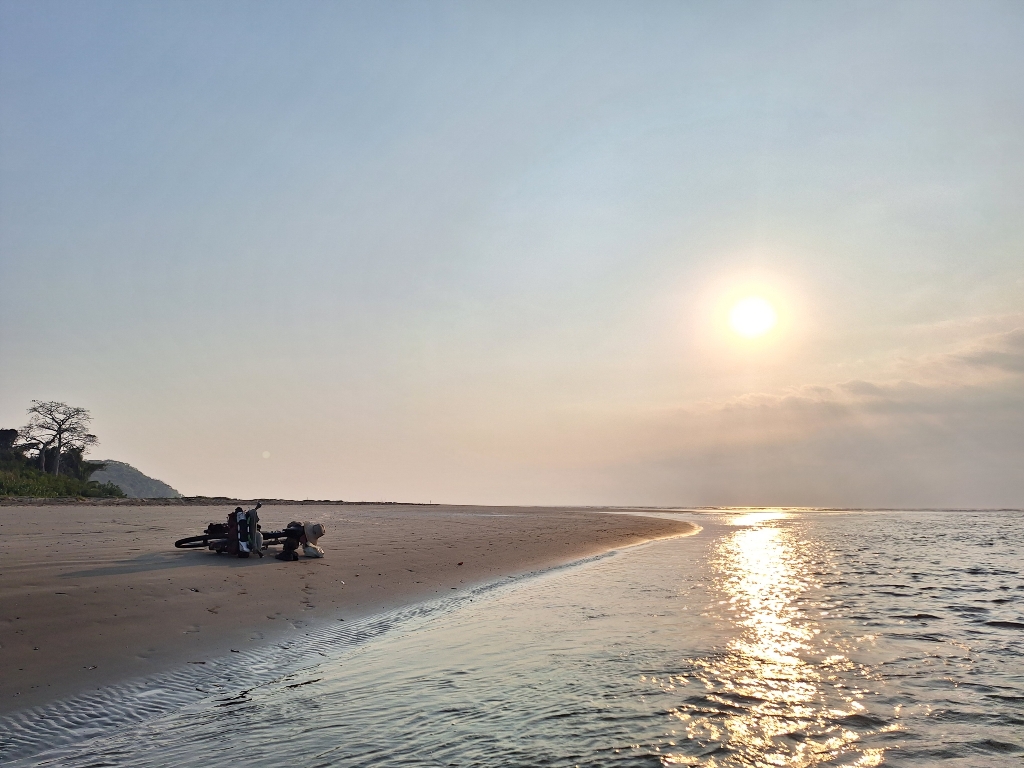
Testing the depths of this estuary; it was too deep to cross

A tough, sandy, dusty, steep day
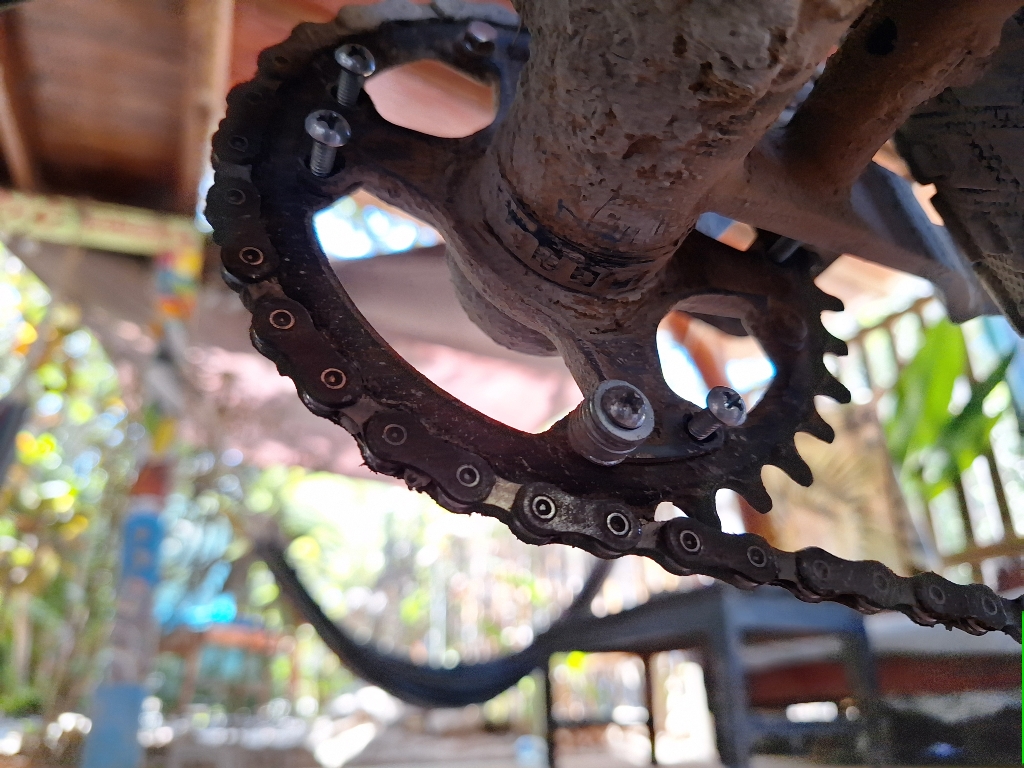
The front sprocket getting worse now. Since April of last year Shimano's advice has been to go to my nearest service center... in Mexico City
I visited a few more ferreterias along the way as I tried to keep my front chainring from falling apart. I’ve been losing bolts since April of last year with little help from Shimano or the retailer. I have two of the original eight bolts left and continue to replace them with whatever I can find locally. I can’t understand the design and why the sprocket wasn’t riveted to the carrier. My best guess is that the way they’ve decided to build it, it looks cooler. It’s gotten me this far, though and it continues to work with an occasional creek and a croak. Eventually, I made it to the border where I had to pay an $$8 exit tax to leave Costa Rica, then $1 to enter the Nicaraguan customs building, and lastly another $13 to enter the country. All travellers had to go through an airport style security check to enter. Everyone had their roll and they made sure that you knew about it. It was all a bit bureaucratic.

It's feeling like autumn
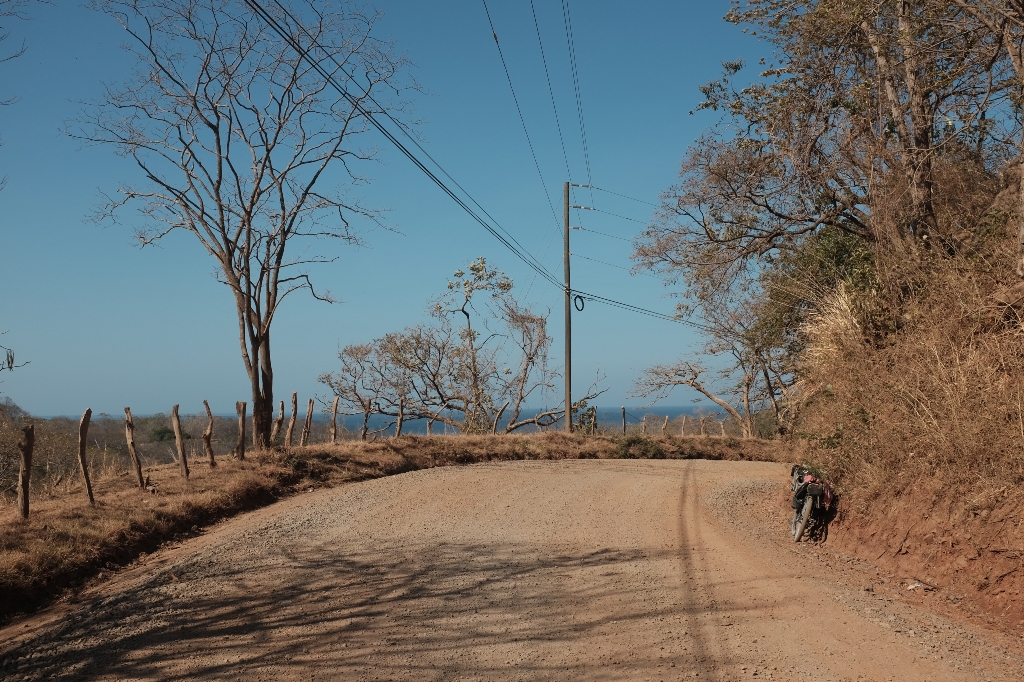
Nice views of the water
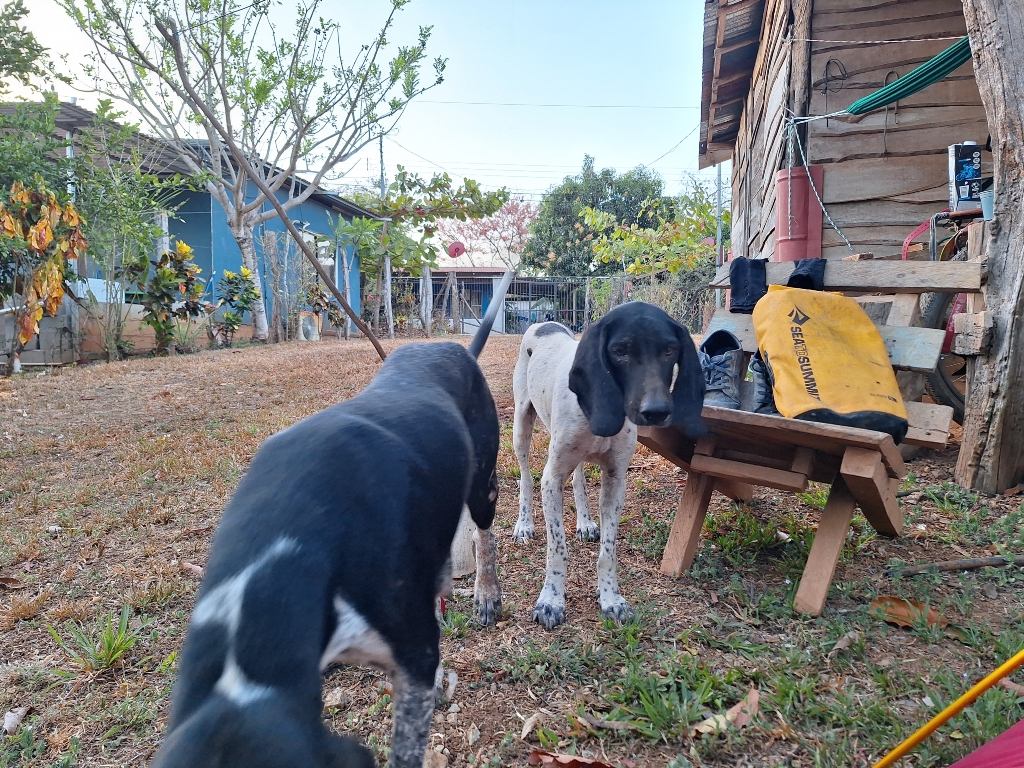
Good morning sir, we heard you had some food. Jose's backyard campsite
Nicaragua
Once in Nicaragua I was feeling good and making good time. As Central America flattens out I’m often underestimating how far I can ride with the day’s remaining light. That first night I made it to Rivas and asked if I could stay at the fire department, which was absolutely no problem. I played with the dalmatian and her puppy for a bit, got some food, and looked at the trucks. I noticed that one of them was donated by the city of Greenacres, Florida and became the inspiration for the title of this post. Most of what I knew about Nicaragua before coming here revolves around the Iran-Contra scandal of the 1980’s. This has since continued to strain US-Nicaraguan relations which has then left room for other countries to fill the void. Of the several fire departments where I camped, each one had a vehicle donated by a different country. There was the Russian Kamaz truck on the island of Ometepe and the Opel Astra of the Hamburg Fire Department in La Paz Centro. Along with all of the old yellow American school buses, these vehicles became a tangible symbol of international diplomacy.

My first glimpse of Nicaragua

Nicaragua doing its thing
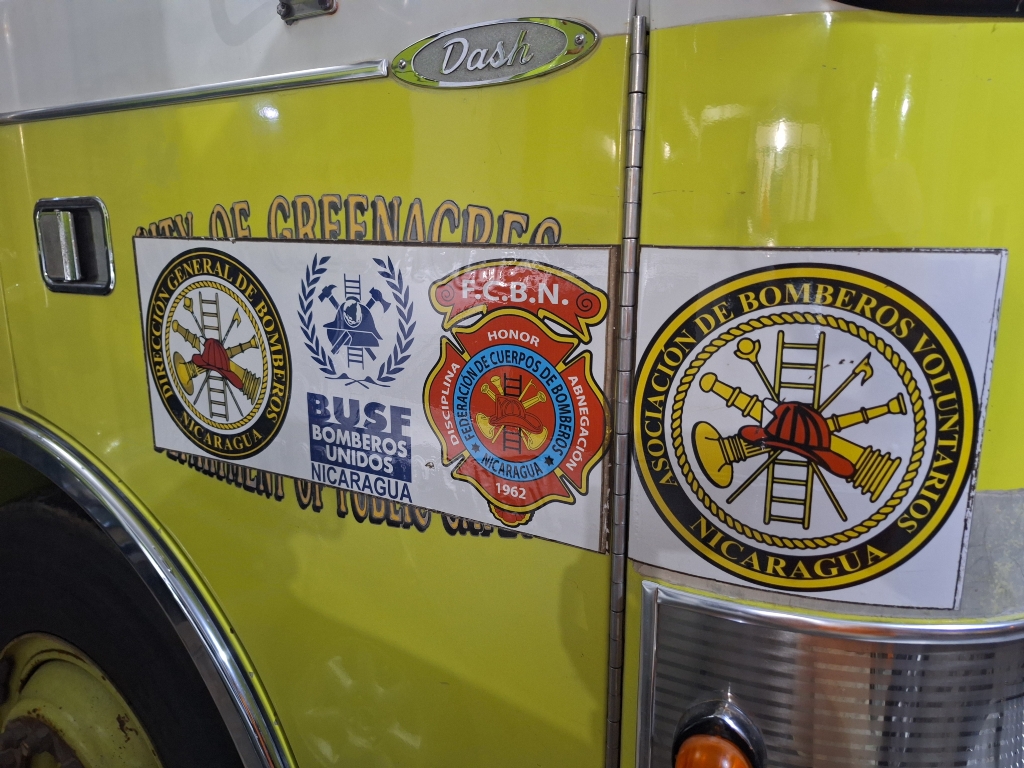
Thank you, Greenacres, Florida
After a short night at the fire department (I had to be out at 5:30 AM) I went to a nearby gas station for a coffee and to wait for the ferry to start running to the island of Ometepe. I crossed on the ms Brakzand (I’m not sure if it was also a donation from the Netherlands) and spent the hour long boat ride to San José chatting with Felipe, a police captain from the capital Managua. Once on the island I had some lunch and rode the rest of the way to Finca Magdalena, a beautiful cooperative coffee plantation where I took a few rest days swinging in a hammock. I’m always slow to get moving when leaving a comfortable spot and this time was no different. I made it to Moyogalpa in time for the last ferry but that meant I’d arrive back in Rivas after dark so I figured I’d turn back toward the fire department I saw a few kilometers up the road. “No problem!” The next day I crossed back to the mainland and rode to Granada in one day. I took a bed in a hostel but only stayed one night.
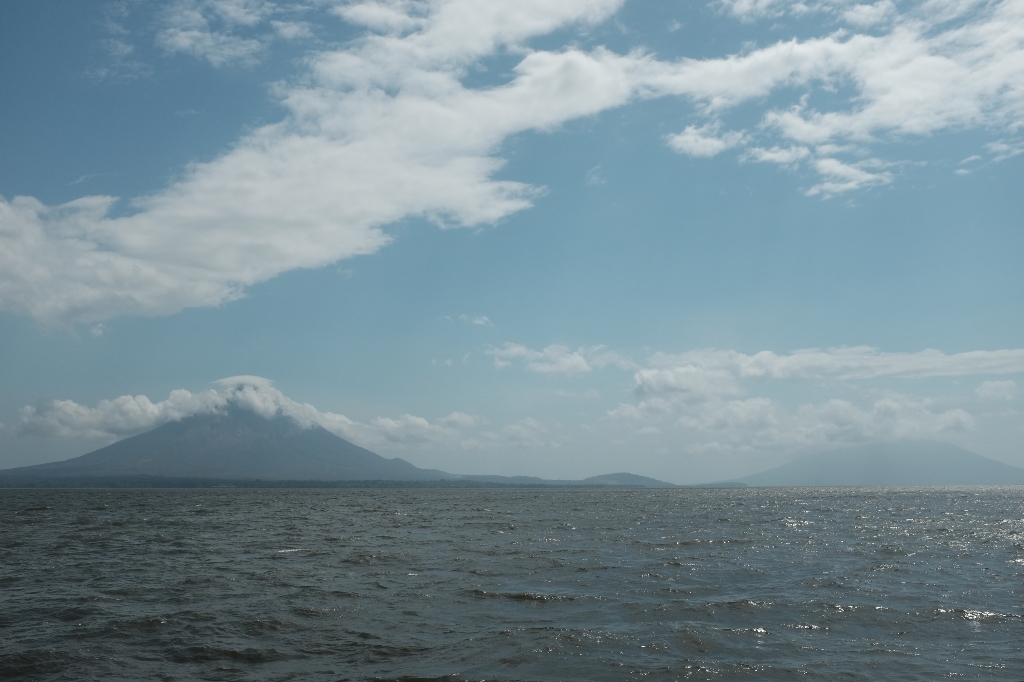
The twin volcanoes of Ometepe coming into view

ms Brakzand now living in Nicaragua
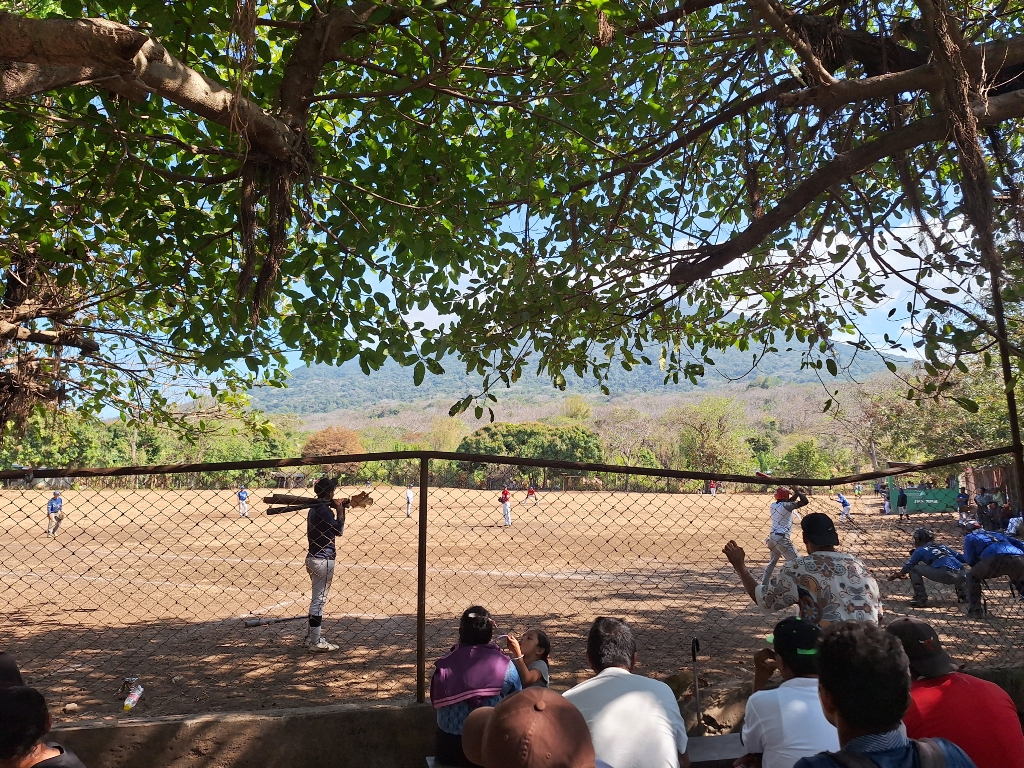
More baseball here in Nicaragua

My view from the hammock here on Ometepe

The Concepción Volcano on a clear day
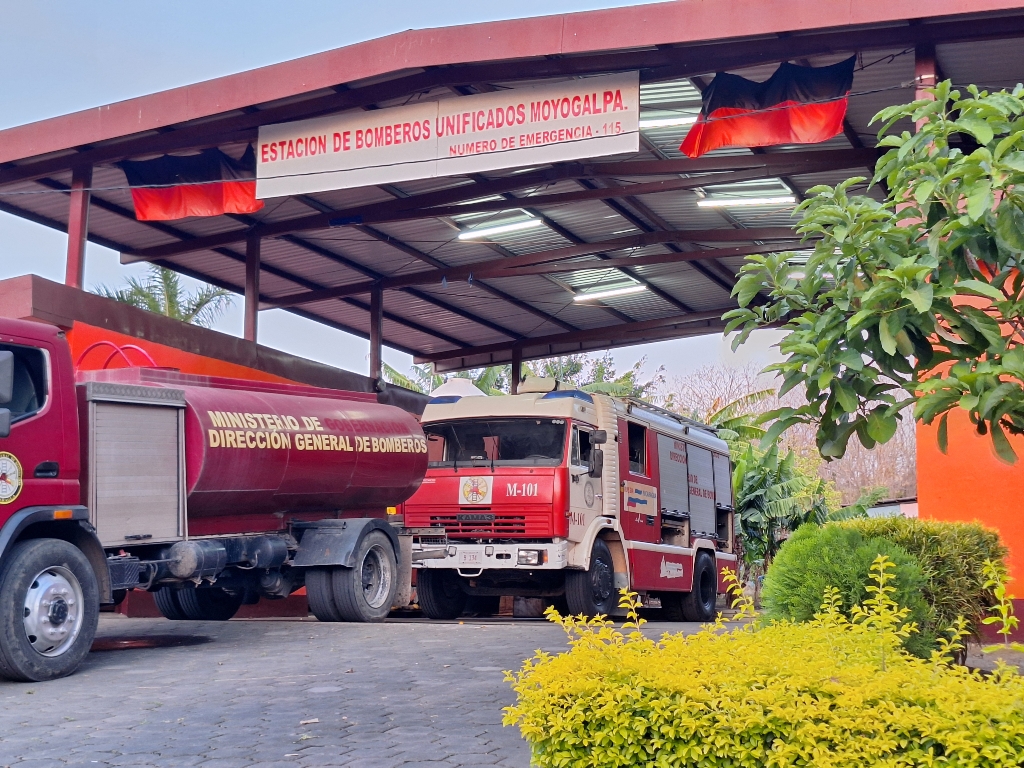
A bomberos campsite
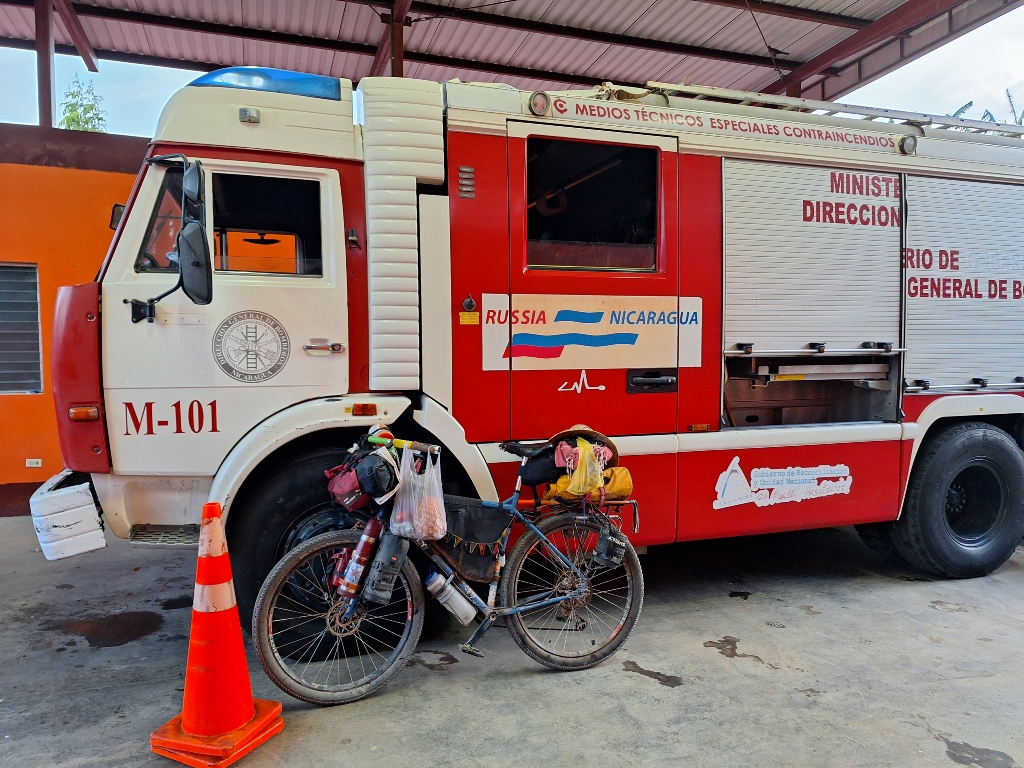
Thank you, Russia
From Granada I cycled around Laguna de Apoya on some steep roads (what else?) and then up and over at El Crucero. I spent one night camping somewhat higher up around 900 meters and had to use my sleeping bag in the nights, something I haven’t done in months. When a few dogs gave chase it also occured to me that this hasn’t happened in a long time either. I figured they’ve probably reasoned that it’s just not worth it in these tempatures. The rest of the ride to Leon seemed pretty uneventful. I stayed at another fire station in La Paz Centro, ate quesillo, vigorón, and my first tacos, and covered plenty of distance. I’ll spend a few days resting in León, seeing some museums, doing laundry, and tuning up the bike. From here I’ll head north to Honduras. The countries are now much smaller and I’m crossing a border about once every week or two so there’s plenty more up ahead!
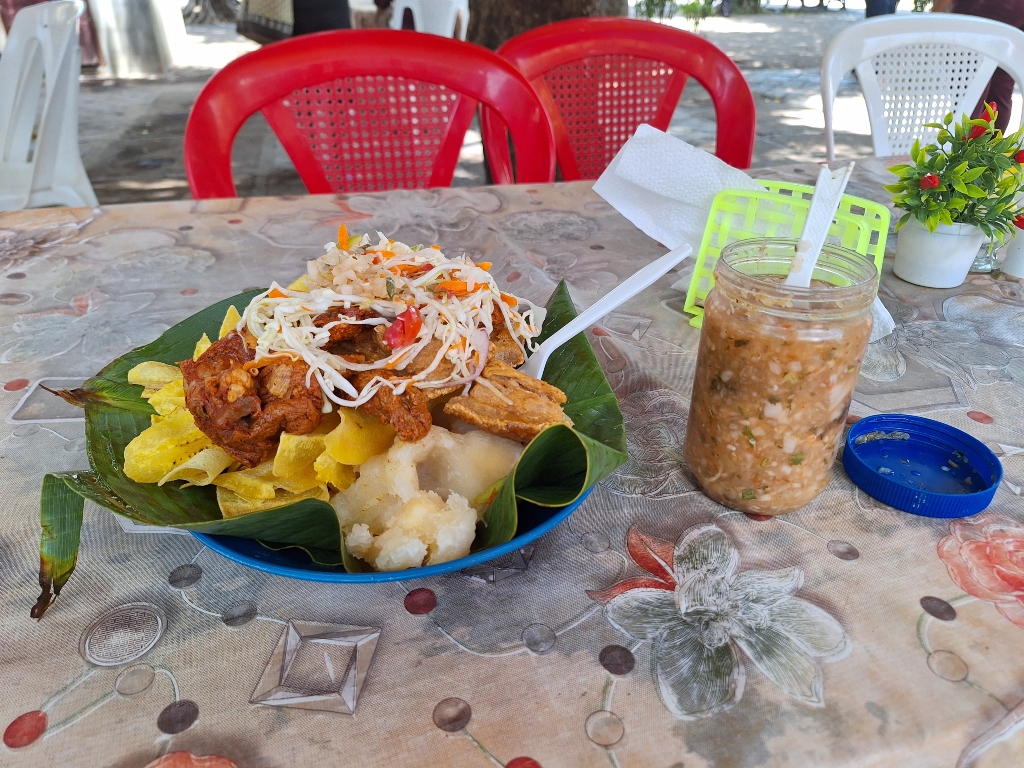
Some Vigorón in Granada
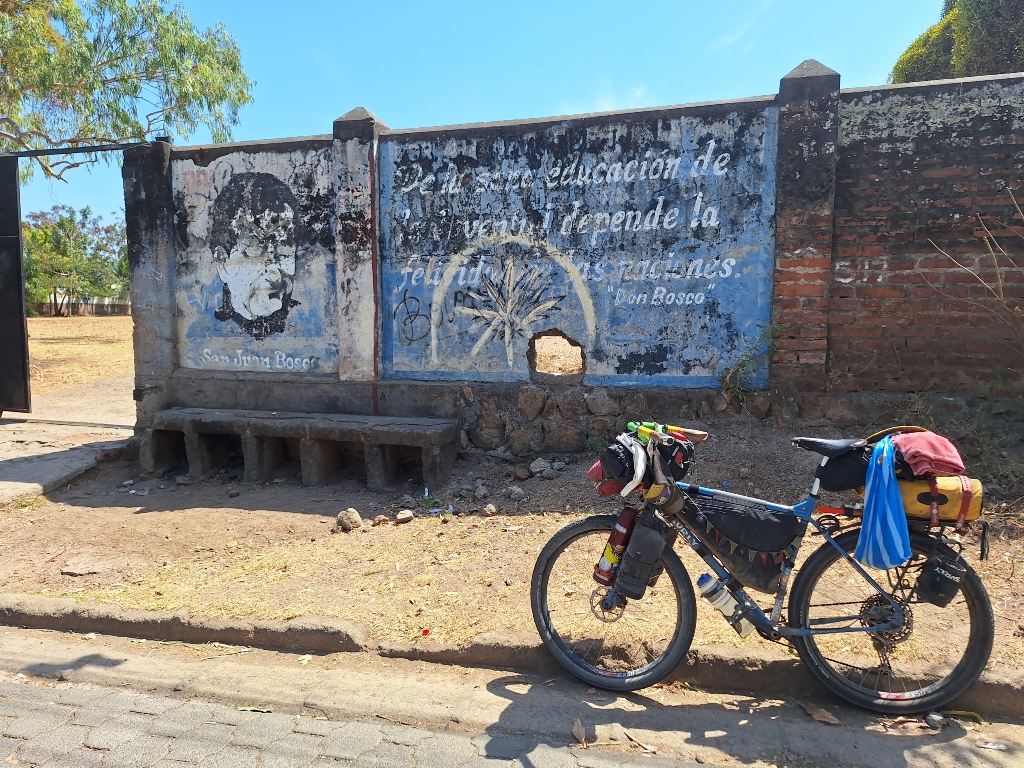
I agree with Don Bosco

A happy looking pig-man

Thank you, Hamburg, Germany
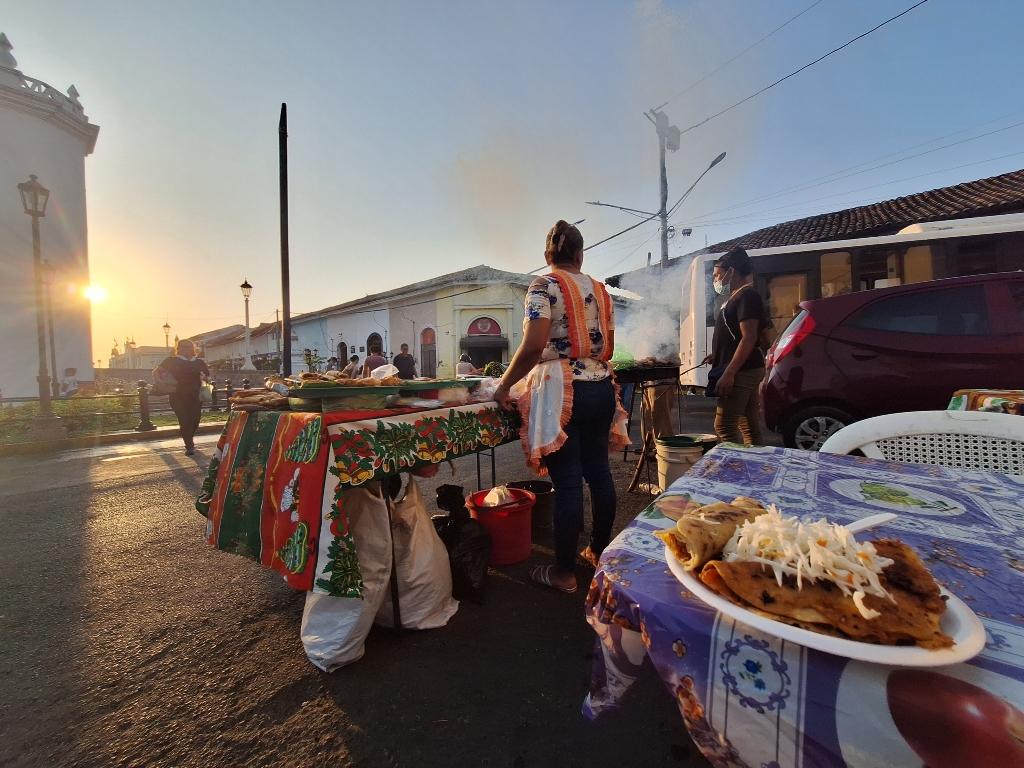
Entering taco country
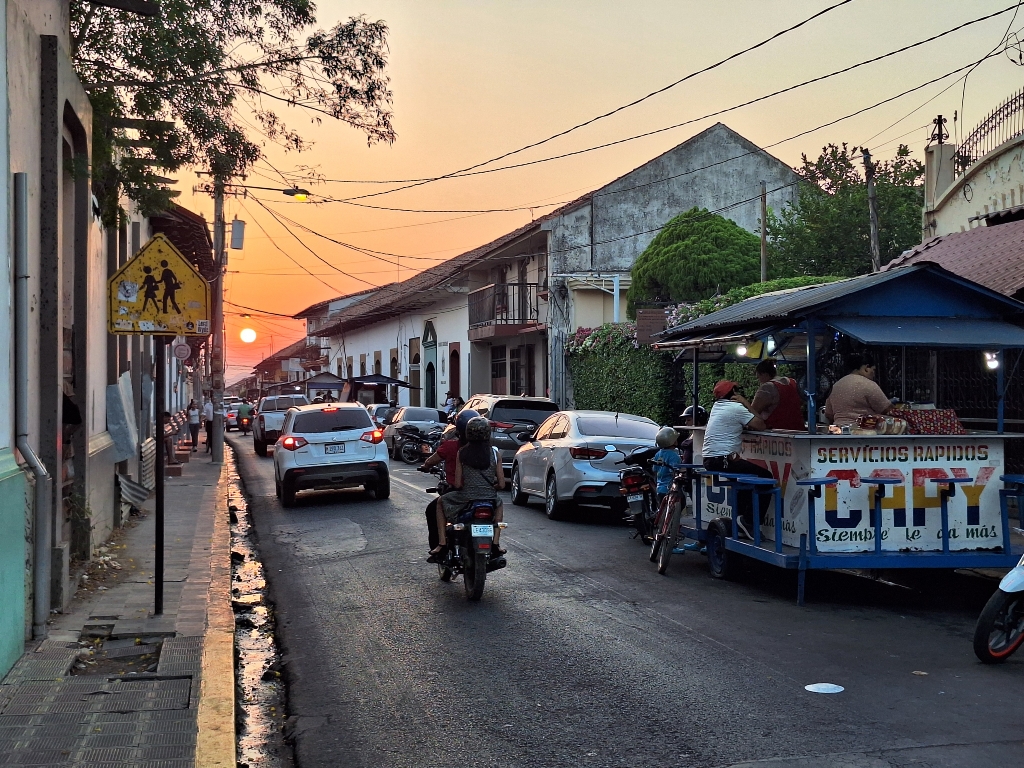
Finally cooling down in León